Central Tramway, Scarborough
Scarborough Spa Cliff Lift, Scarborough
TODAY'S ITINERARY
Exploration: Friday, 21 June, 2019
lv London Kings Cross 0730 London North Eastern Railway
ar York 0932
lv York 0945 Transpennine Express
ar Scarborough 1035
lv Scarborough Transpennine Express 1544
ar York 1635
lv York London North Eastern Railway 1658
ar London Kings Cross 1849
At Scarborough I could check off two funiculars on my list in one day. In fact it turned out to be two plus a third one out of service but mostly still there. Not only that, I could sleep a little later: the two long journeys were done, and this would be three hours out, not five or six. I took breakfast at the Costa near the hotel and walked up the street to Kings Cross.
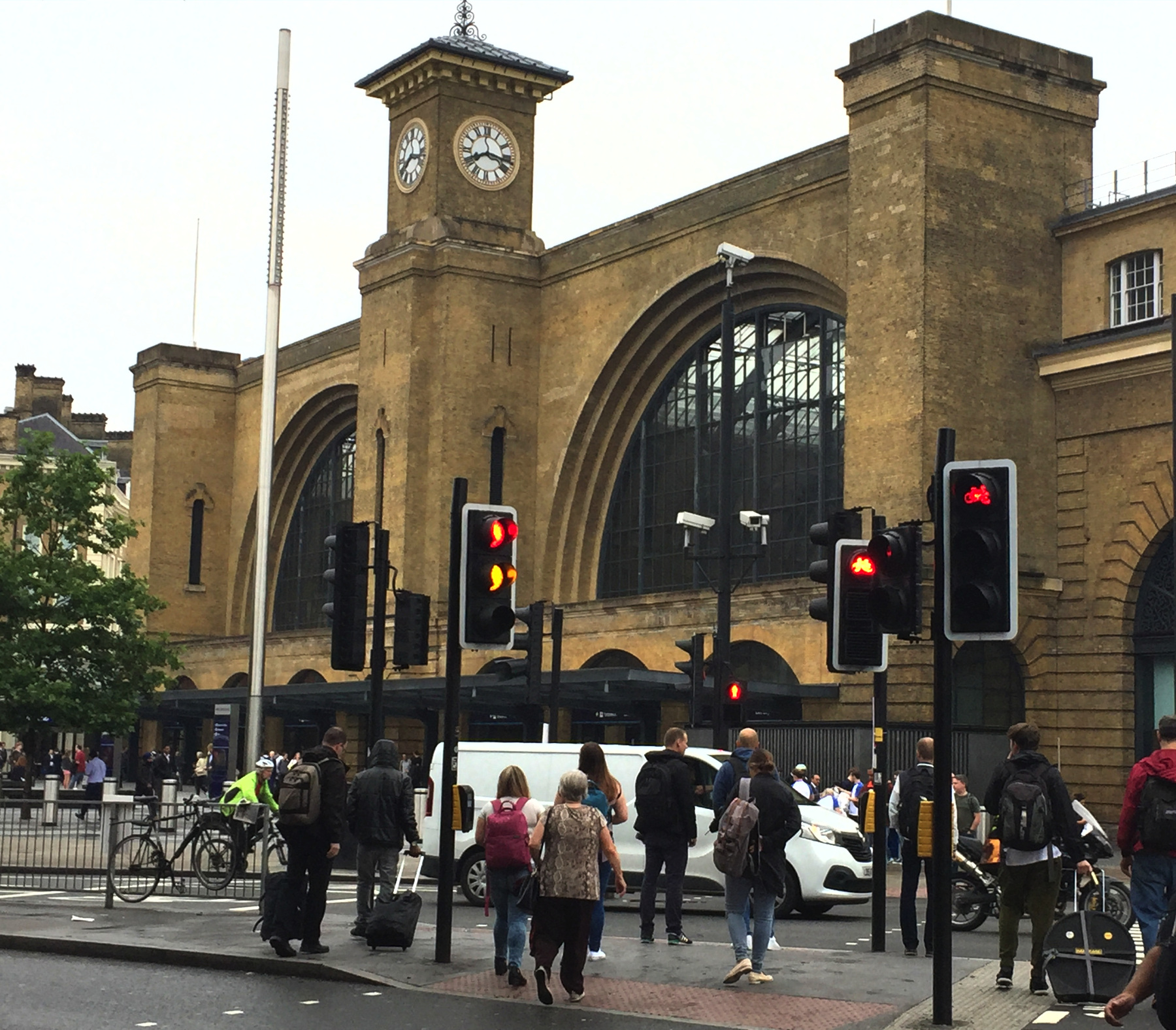
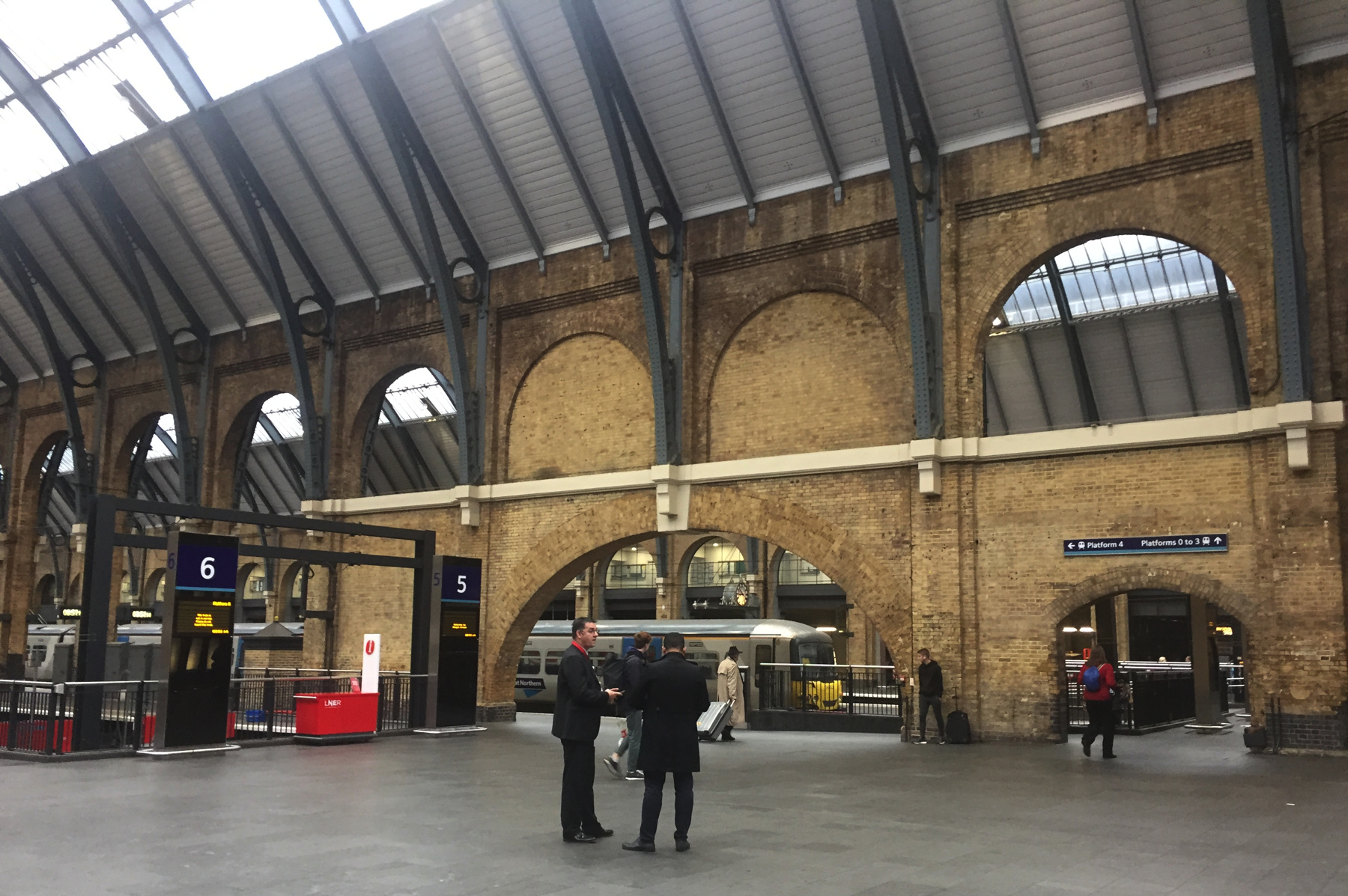
Kings Cross. I love its honest expression. Dating from 1852, it is not the oldest London terminus, but I think it is the oldest original building and trainshed still in existence, two years older than Paddington. It does not hide anything. It does not pretend to be more than it is. As you approach you can tell that there are two large arched trainsheds—why hide that behind some fancy head house? It is what it is. The oversized mantel clock lets you know whether you will make your train.
In the terminal's twenty-first century form the ticket offices and waiting rooms are in a modern extension to the left, and there are a few more suburban platforms over there too. The addition is both uplifting and functional, and it respects the original by supplementing it without ever competing with the bold simplicity of the original arched roofs. While Paddington stirs my soul, its greatness is hidden from view behind a hotel and other buildings. The exterior of Kings Cross stands there for all to see, and why should it not?
Platforms (tracks) 1 to 4 are in the eastern arch, and 5 to 8 in the western, but if you enlarge the second picture enough you will notice on the sign that there is also a platform 0. Because of increasing ridership, in 2010 another track was fitted in against the east wall where there had once been a road for cabs. Rather than make it platform 1 and renumber all the other tracks, it was made platform 0. There are six other platform zeros in Britain.[note 1]
With its speed limit of 125 miles per hour the East Coast Main Line is one of the fastest in Britain except for High Speed 1, the new railway from St Pancras International to the channel tunnel. Trains make the 174 miles from Kings Cross to York in about two hours including a few stops.
In the fields between Peterborough and Grantham is the hillside called Stoke Bank, where Mallard set the all-time record for steam locomotives of 126 miles per hour (or 125, or 124). There is or was a large sign at that location on the east side of the railway, honoring the pre-eminence of British railways. Photos online as recent as 2016 show that it was still there, but I was unable to spot it in 2018 or 2019 while running at just about that same speed behind electric power. And doing it running up hill, Mallard.
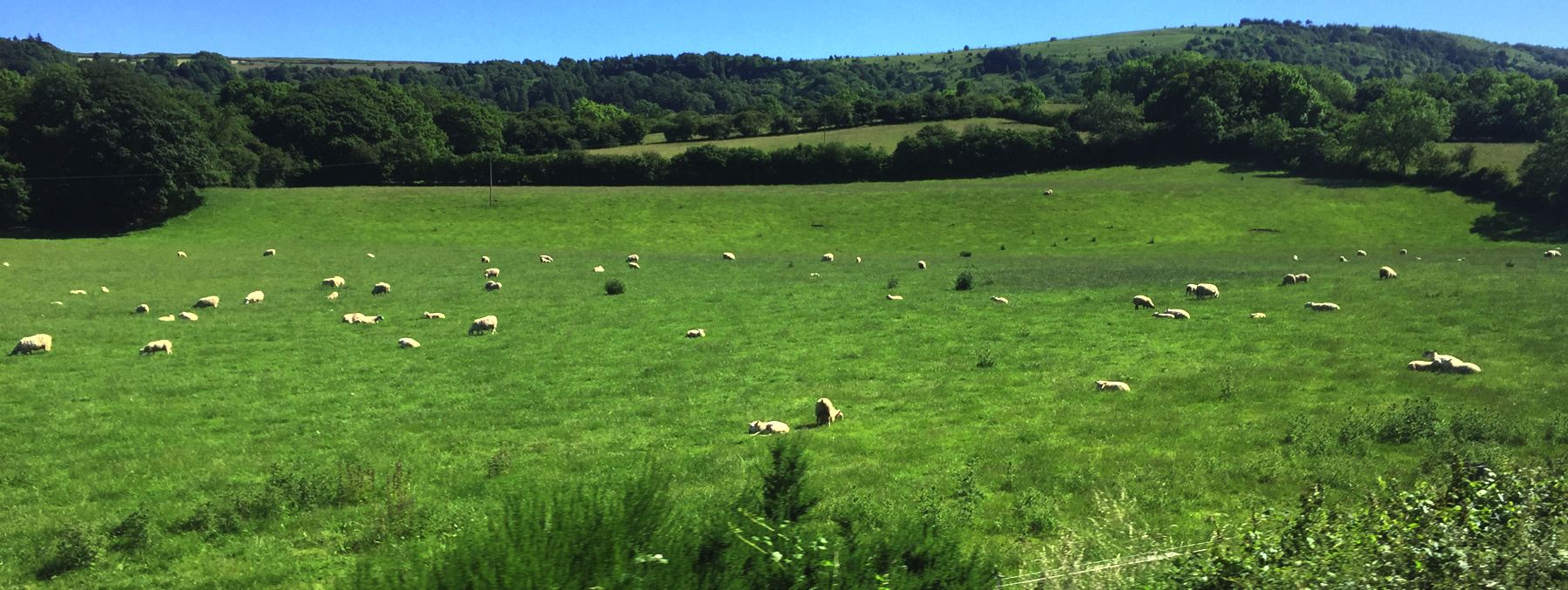
The National Sheep Association puts the sheep population of the United Kingdom at 33 million. I saw many of them.
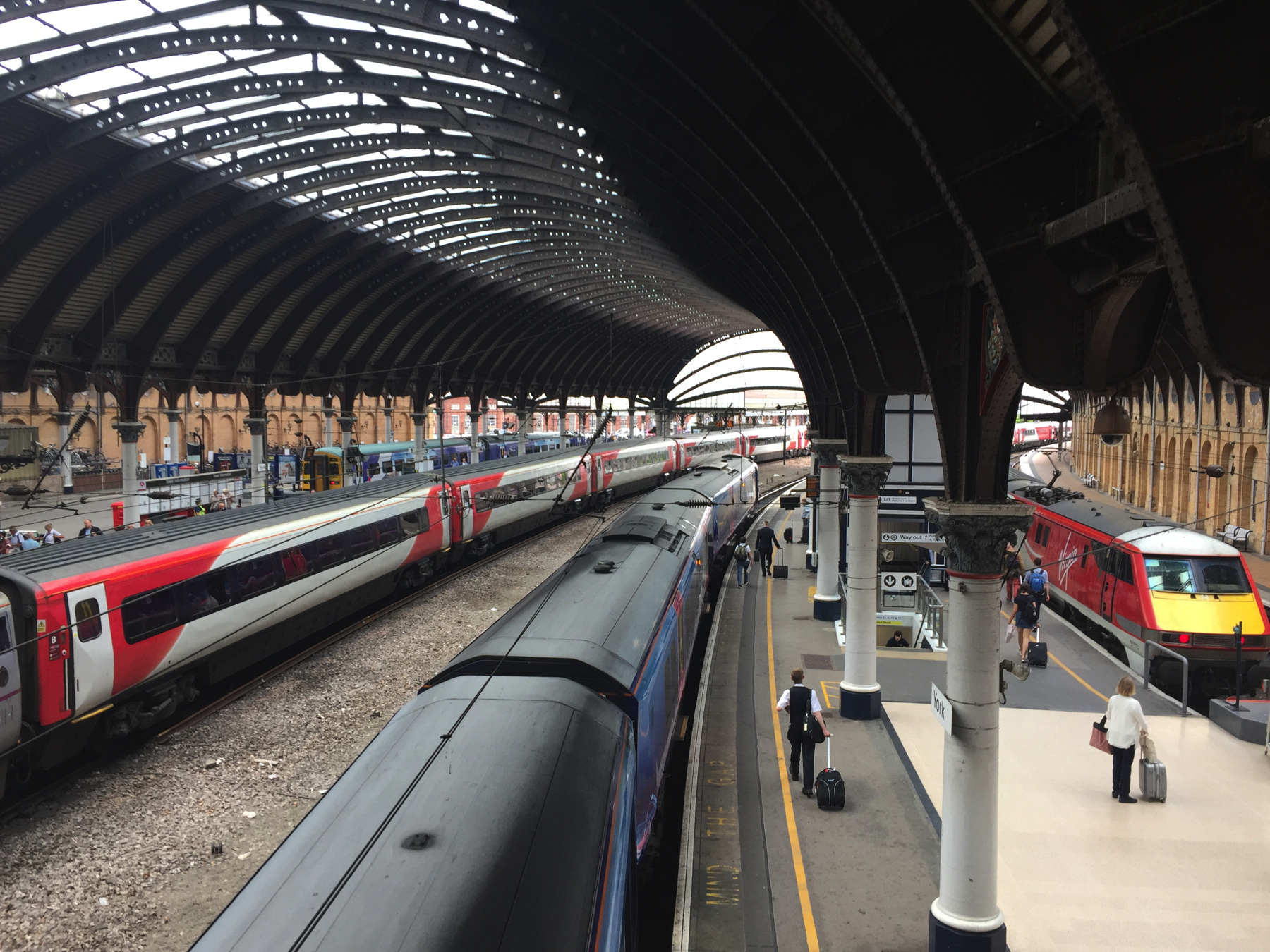
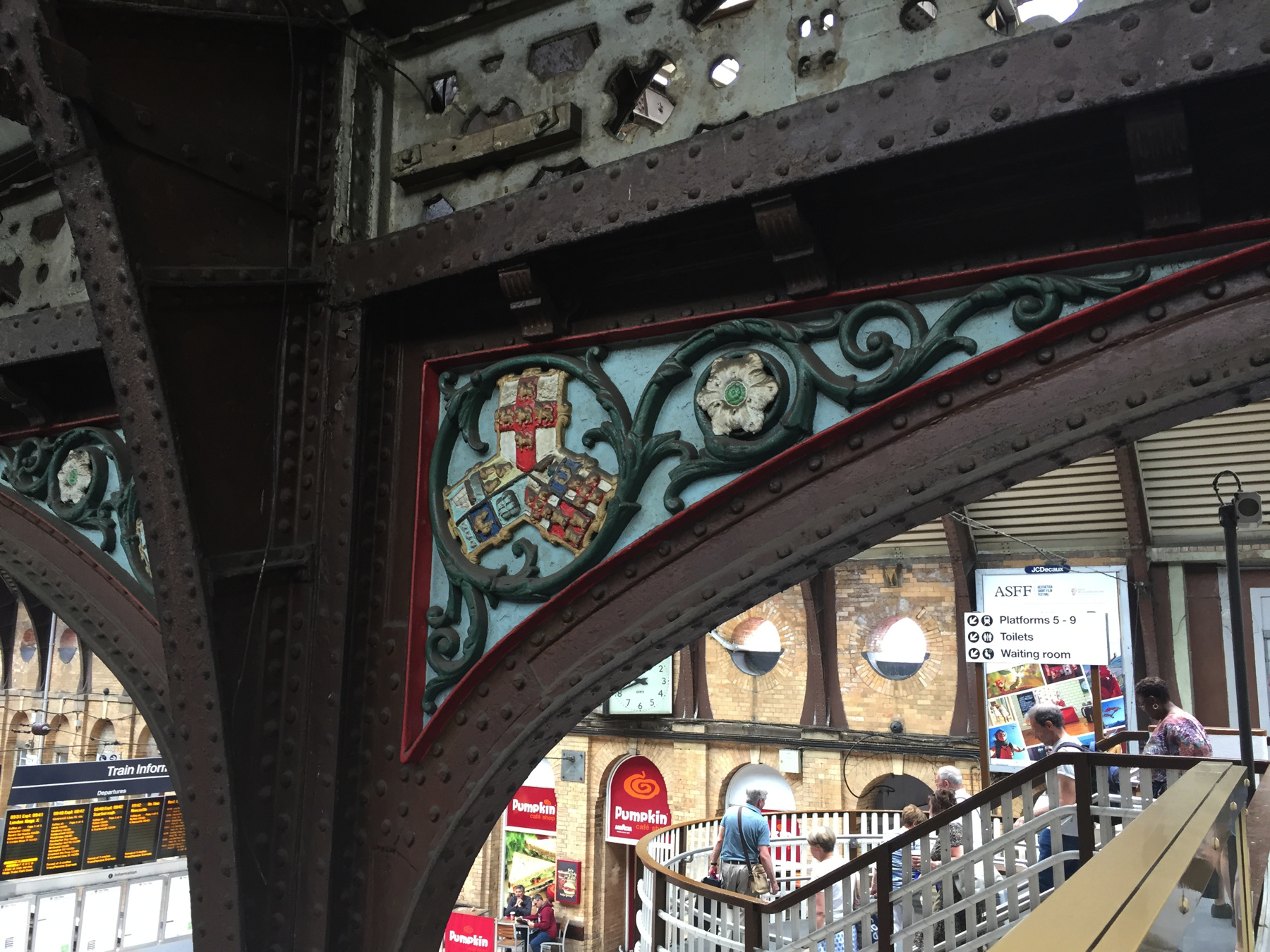
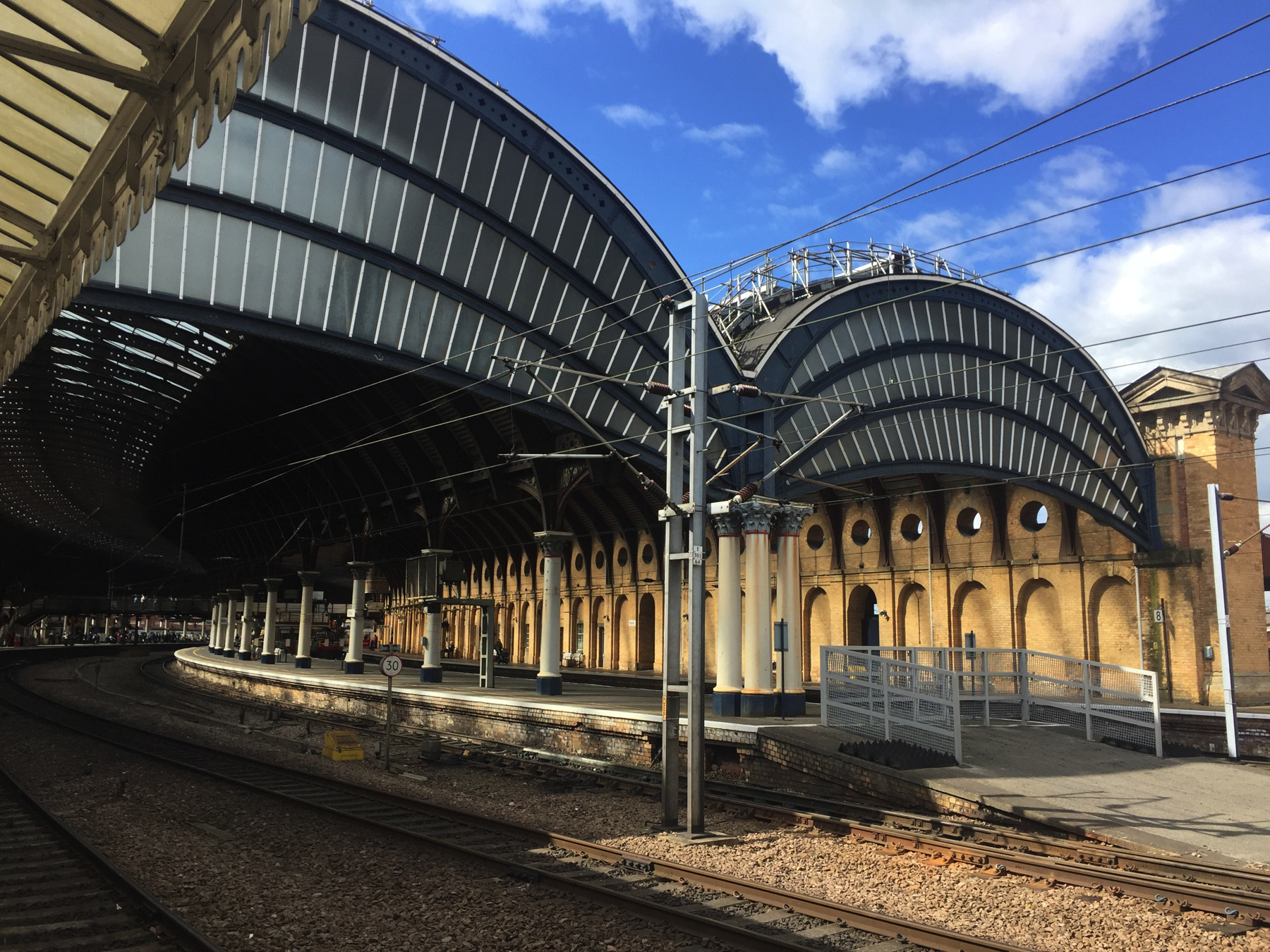
I loved the curving train shed at York the first time I saw it back in 2001, and it still does not disappoint. There are additional platforms on the west side outside the great arches, but I am always glad to arrive and leave under the main roof. The top two pictures are from 2017 when Virgin had the franchise that has since passed to London North Eastern. The third one was from my funicular trip, when I had to walk outside to the platform for the Scarborough branch train.
I was not taking notes on trains as I went, but from the picture below at Scarborough I can identify my train as a 185 Desiro three-car unit.
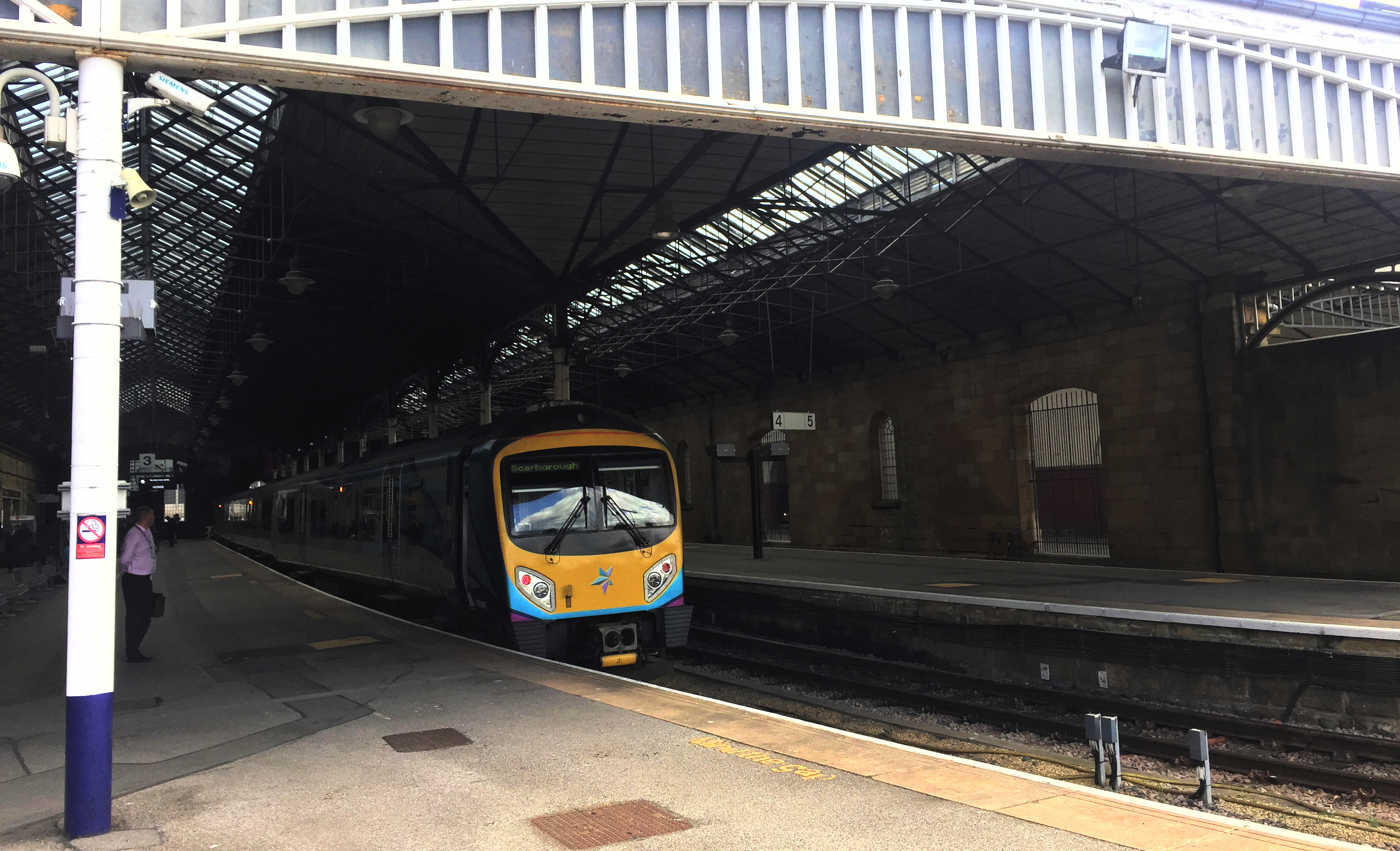
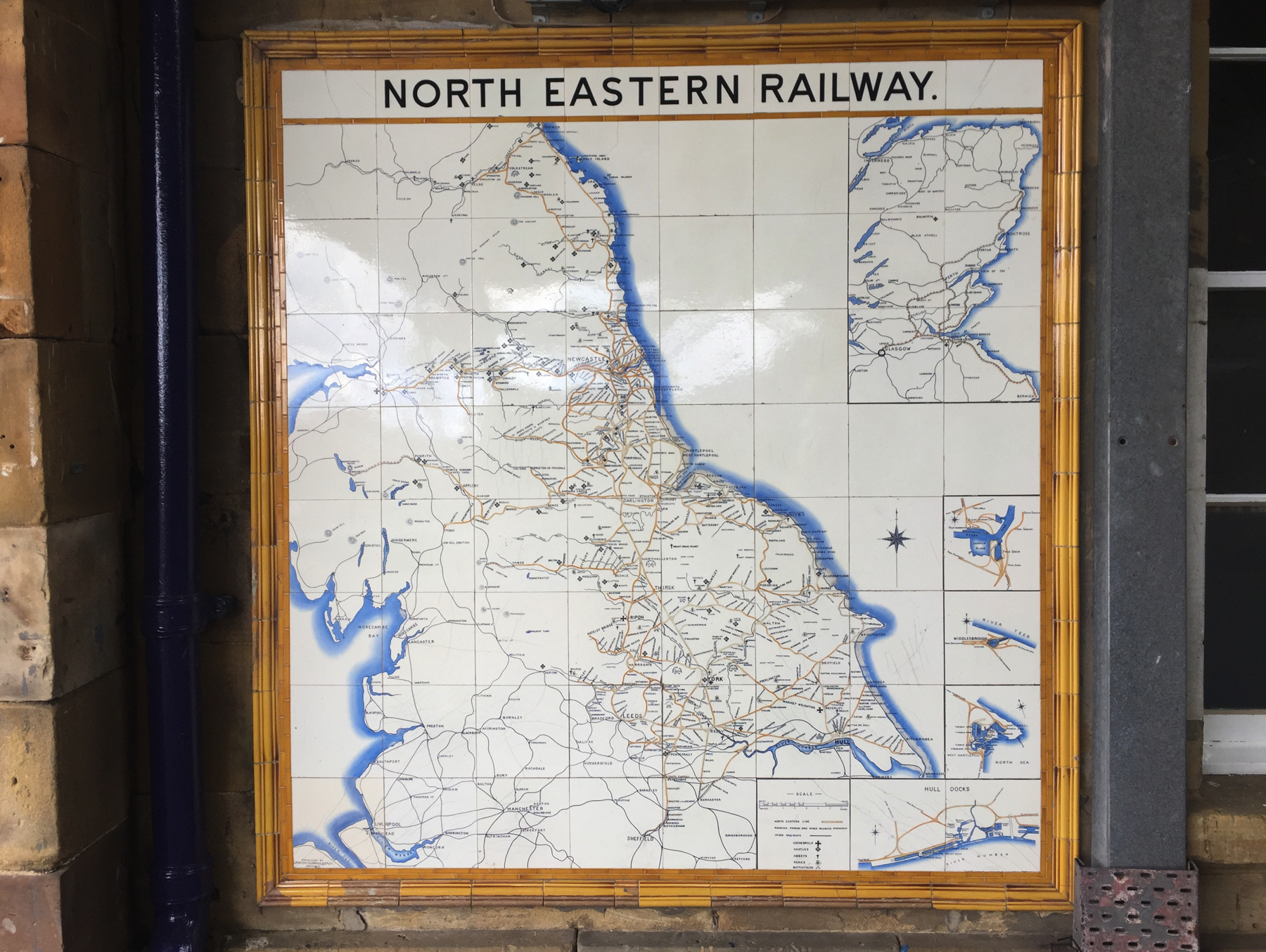
Scarborough station still has its North Eastern Railway tile map from 1900. (York has another of the nine survivors.) But there's something even more notable at the station.
If you have a few minutes, be sure to walk down the very long platform 1 to see the longest (or is it widest?) railway station bench in Britain, and maybe the longest bench anywhere. It has 57 sections (between arm rests), each the length of nine of my shoes, and the unofficial measure of 513 Joe shoes is, I am told, 456 feet in standard measure. It's nice to see that not long ago they've replaced the wood and painted it a striking blue. No one waits for a train this far from the station building, but no doubt paucophiles come regularly to appreciate its form.
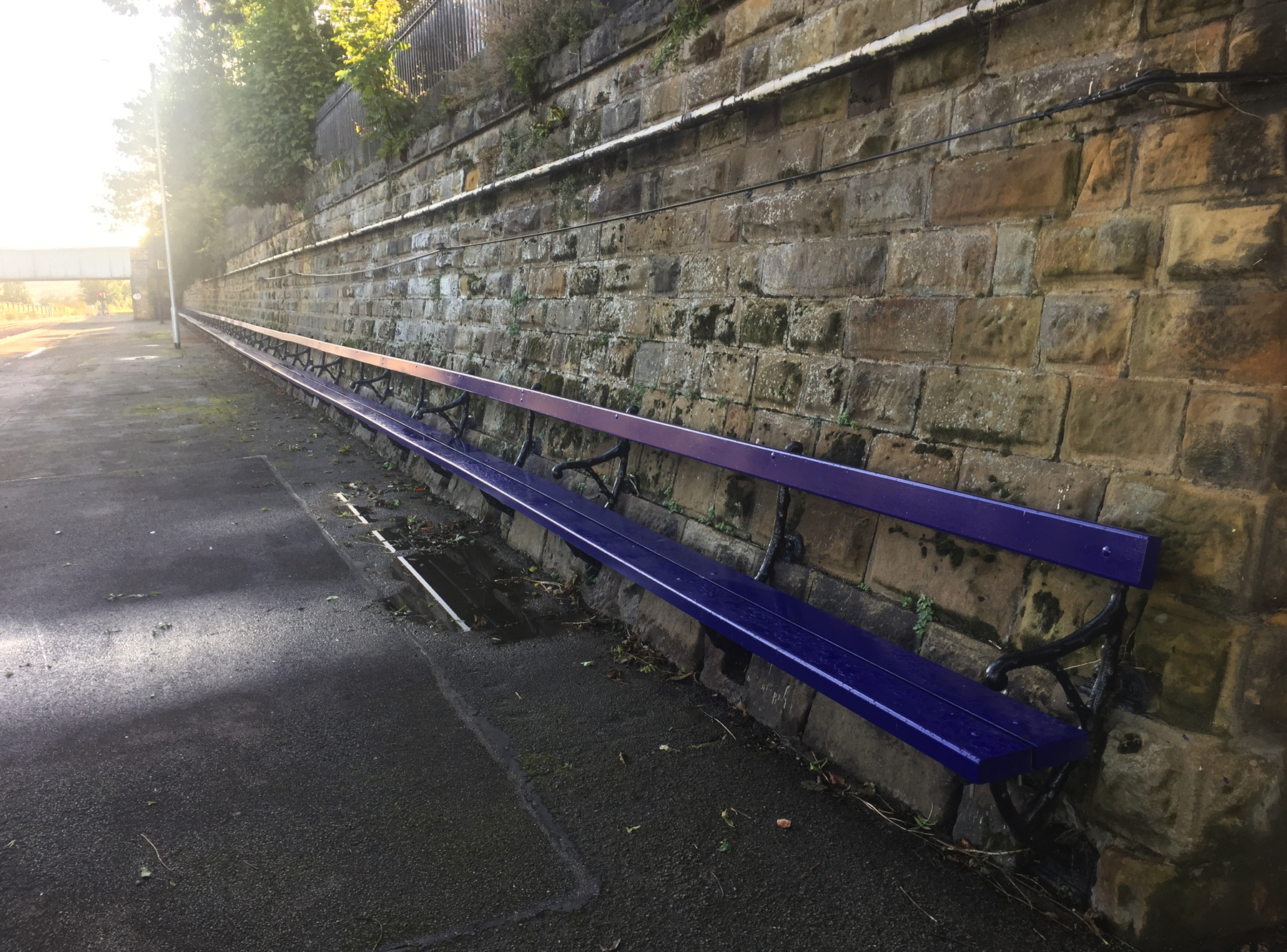
The bench and the former station house with an iron and glass canopy make up the Excursion Station added in 1883. Excursion trains offered special low fares for the working classes, and some effort was taken here to separate them from people paying full fare. The station had its own entrance to the street outside, and probably excursion passengers were directed to use it rather than go through the main station. But in addition to any class considerations a second station house was needed just to handle the crowds Scarborough saw in the warm months. That the excursion station had a cab road suggests that some of the passengers using it had a few shillings to spare, and so does the idea that the long bench was once under a canopy. I do wonder about the reason for the Star of David in the ironwork— but certainly not all excursionists were Jews. A distinction continues: Historic England has given a Grade II listing to the excursion station separate from its Grade II listing of the main station.
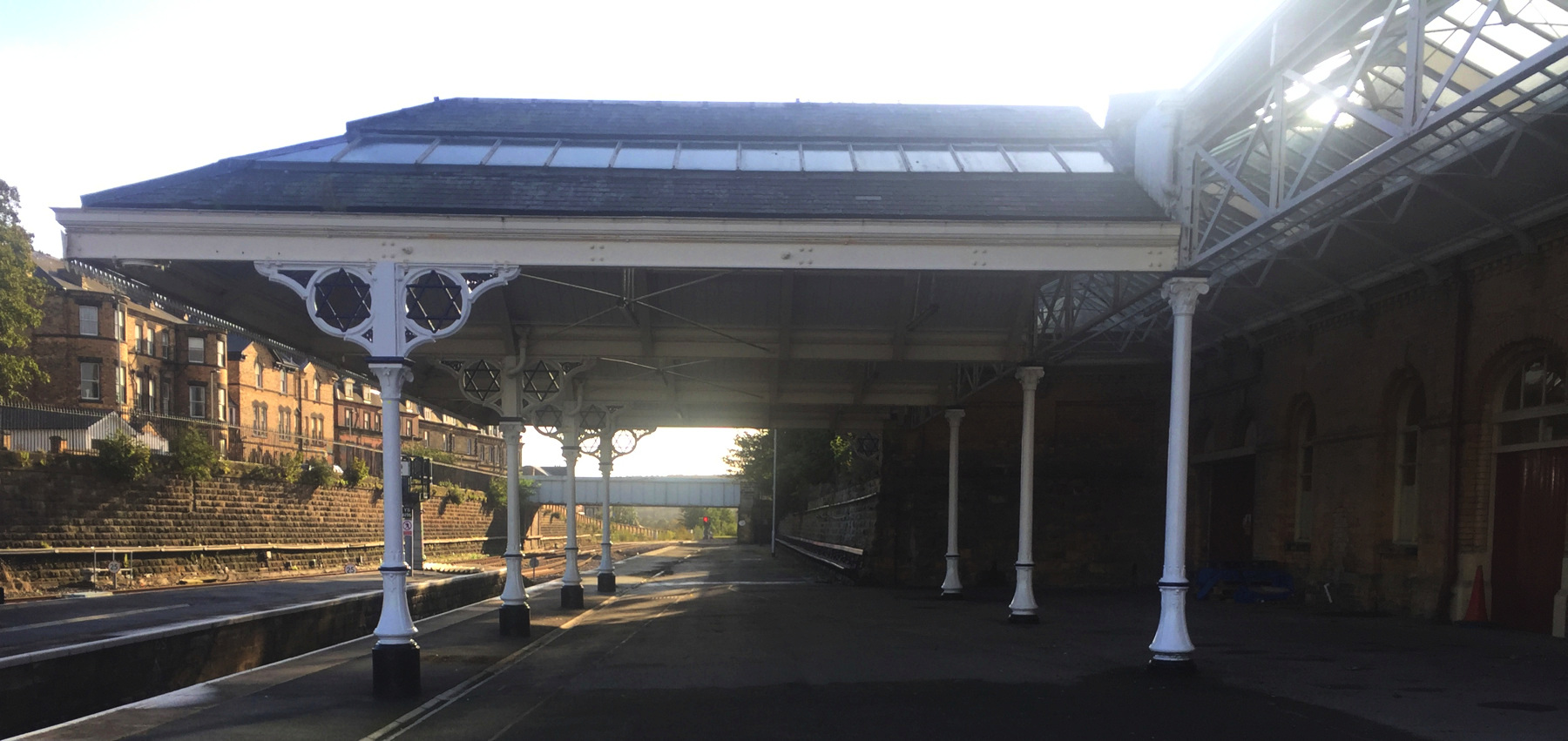
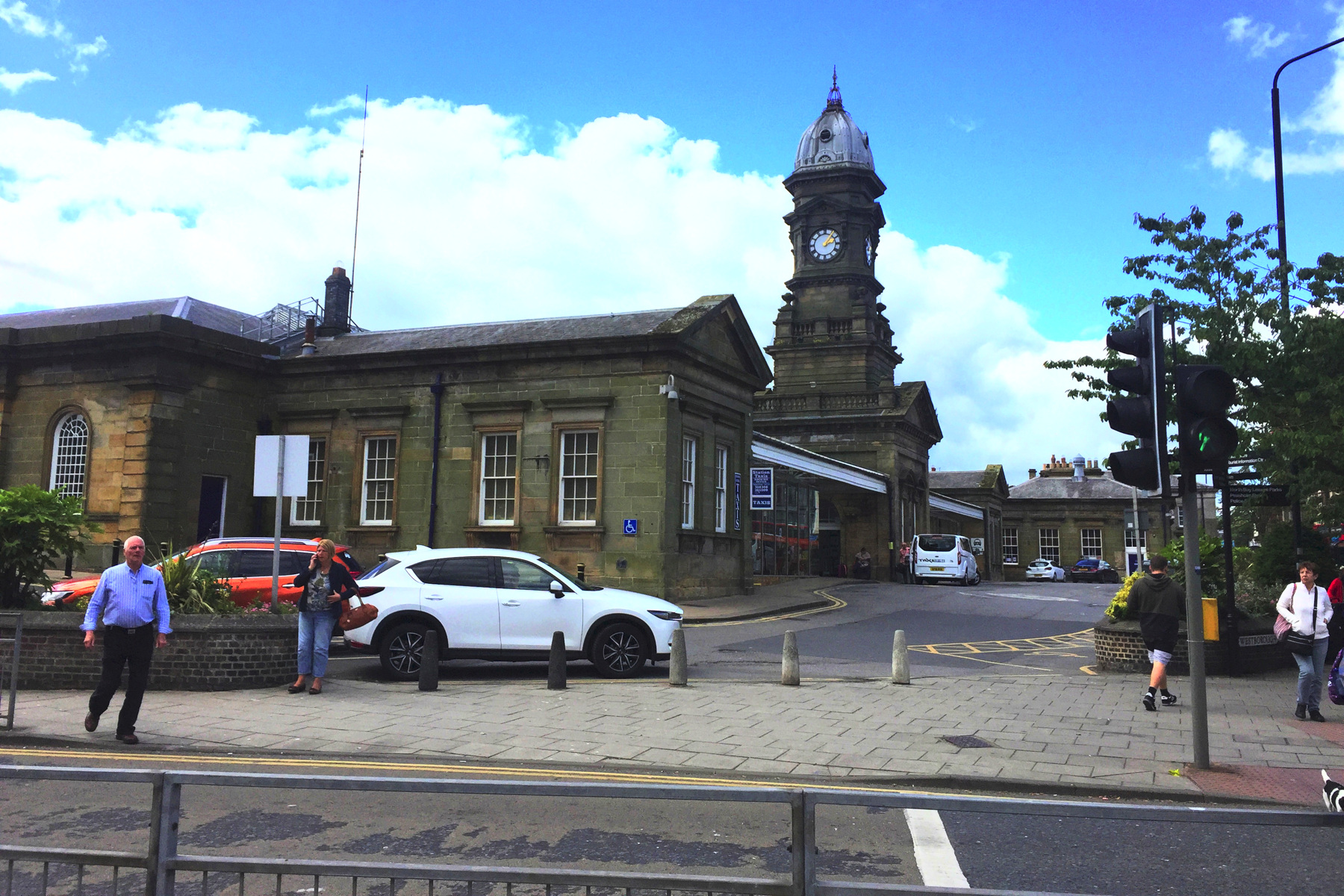
The main station has a very oversized clock tower. The cab road in front is now also the bus station, from which you can get to Whitby. (Something about the weather on this date gave the camera trouble. If the sky looks odd in some of the shots please realize I am trying to get the main subjects looking right.)
Central Tramway
The Central Tramway is a few blocks beyond the station, on the north side of the Grand Hotel overlooking the coast of the North Sea. The "tramway" has been operated by the same company since the beginning, and they are doing a terrific job promoting it and maintaining it. The upper station still has its Victorian feel, and the signs and the name of the Cat's Pyjamas cafe keep it fun. It's not a boring museum of old times.
A zig zag immediately to the north provides side views of the railway. The Grand Hotel is in the background. As you can see the funicular is mostly above ground level on an iron viaduct.
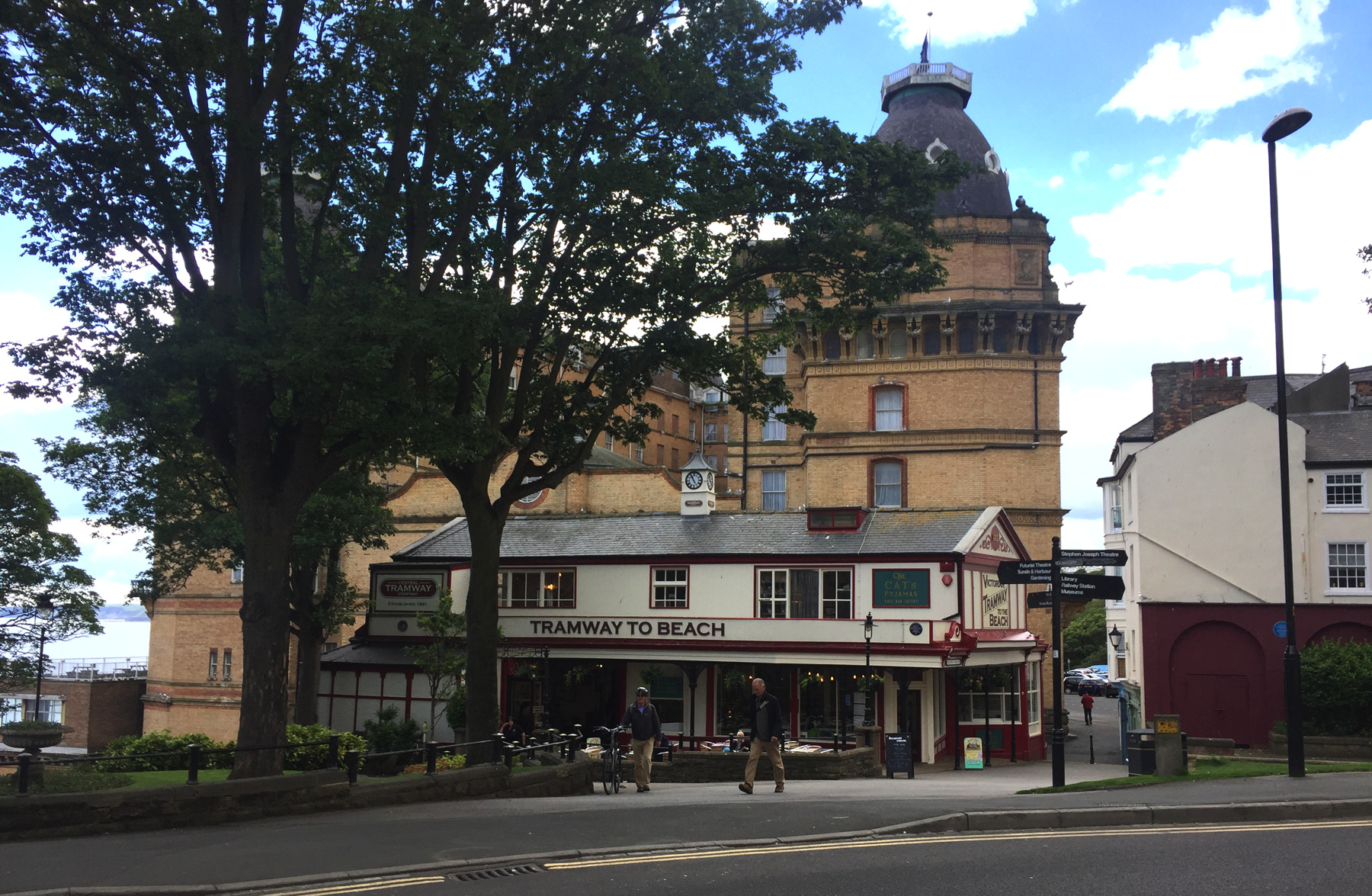
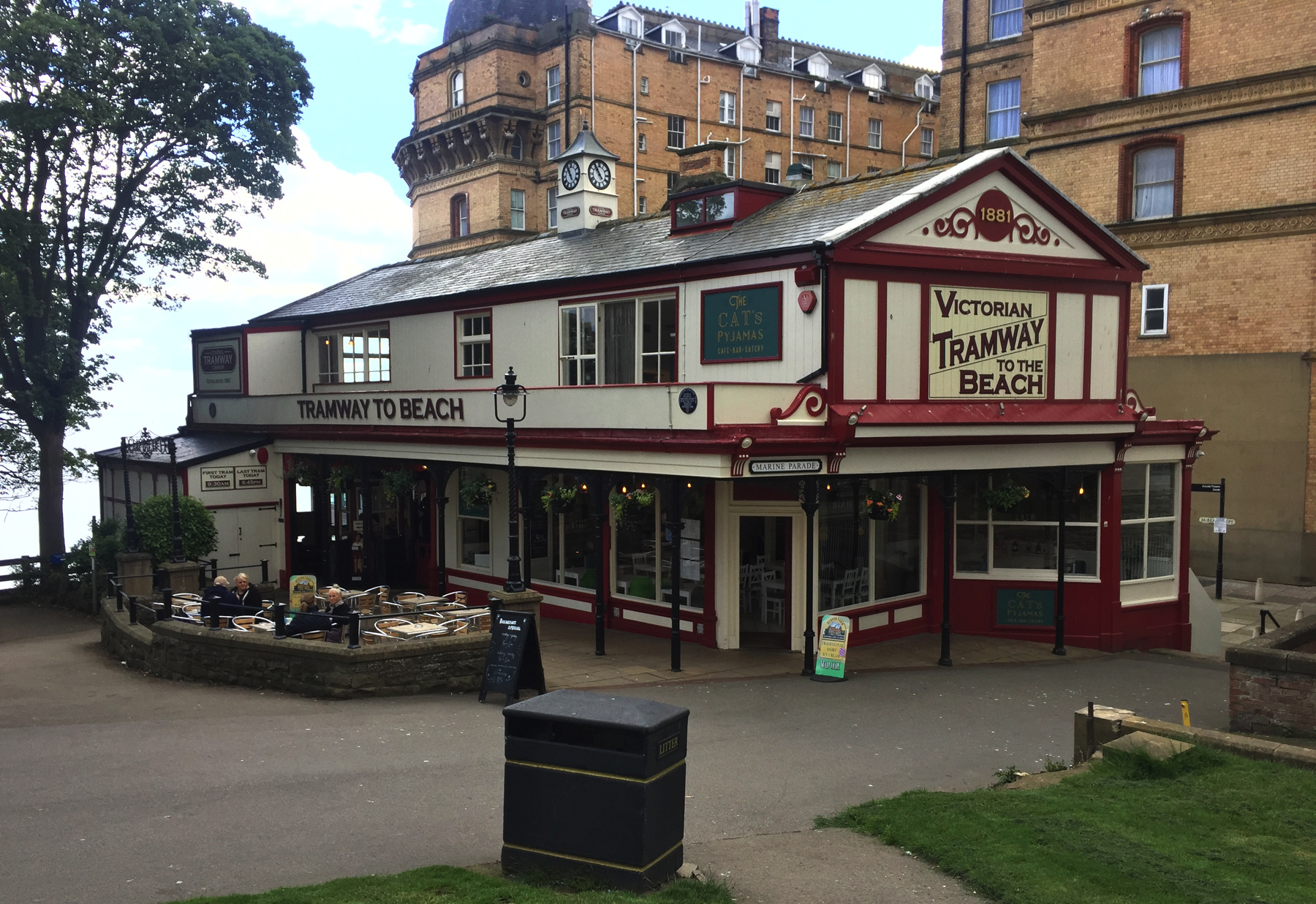
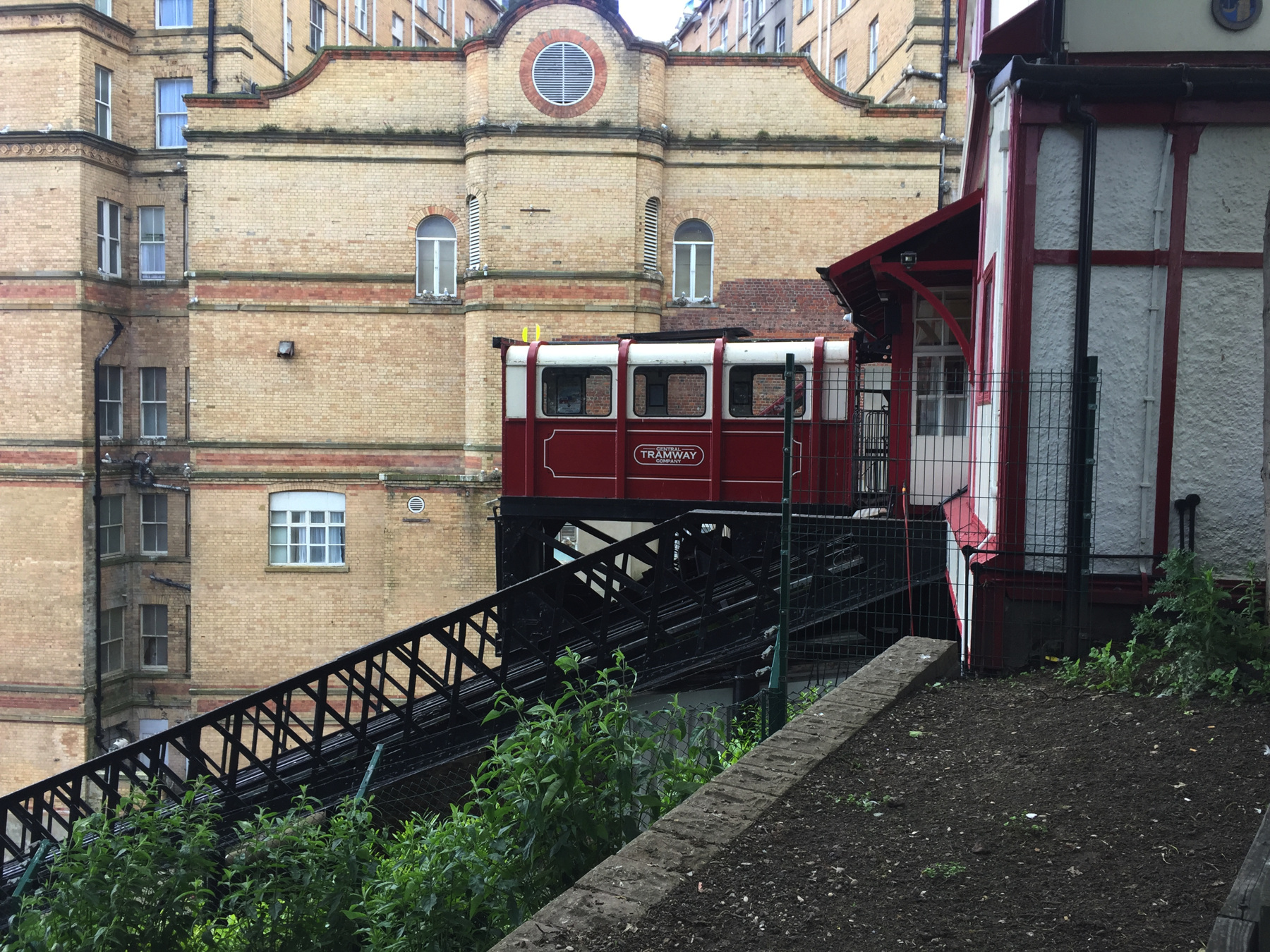
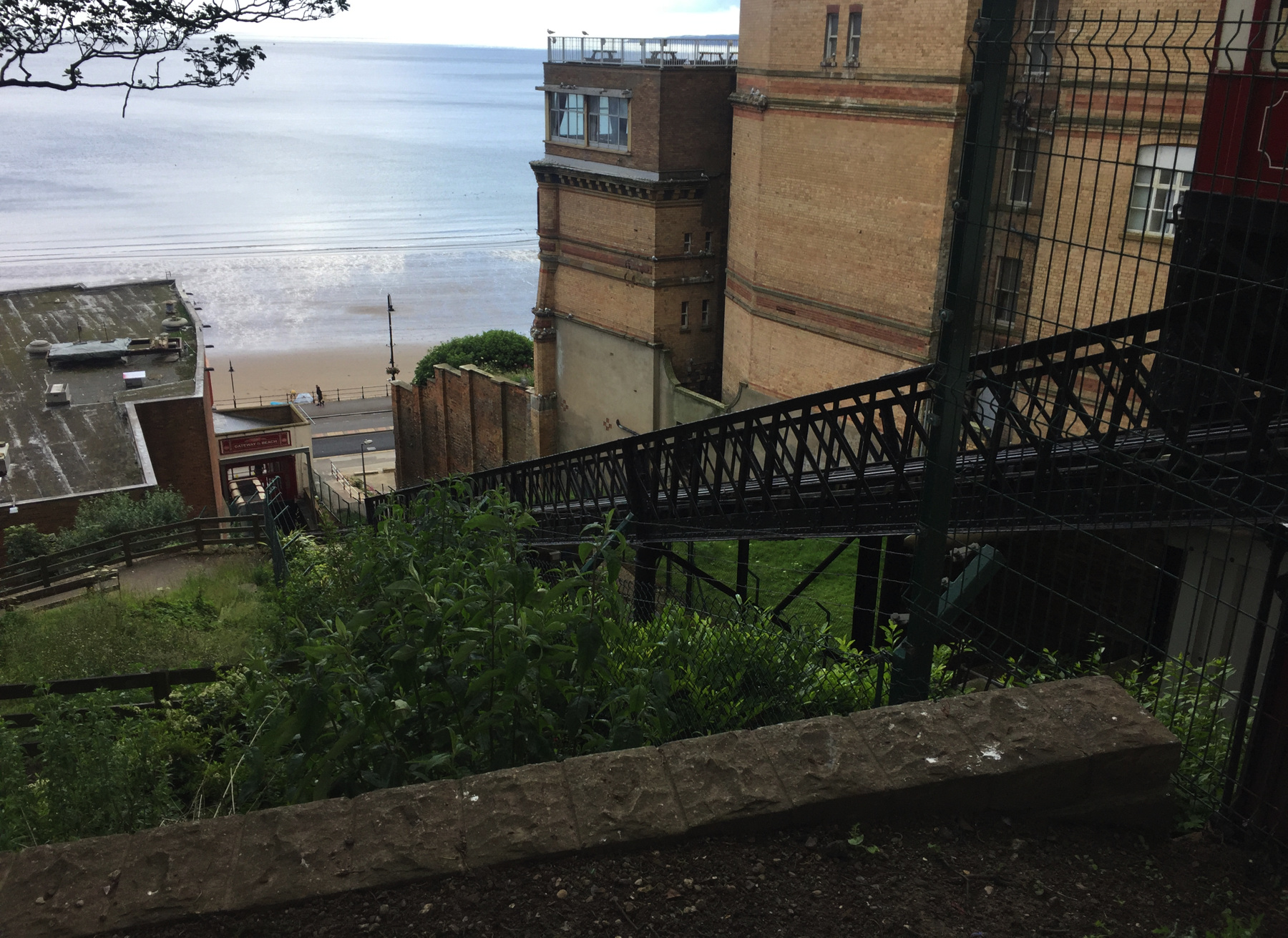
The cars are connected on their upper ends by a quadruple steel cable. The present concrete building cannot be the original lower station, but it may be the same size. In addition to the zig zag on the north side, there is a public stairway full of bird dung on the hotel side.
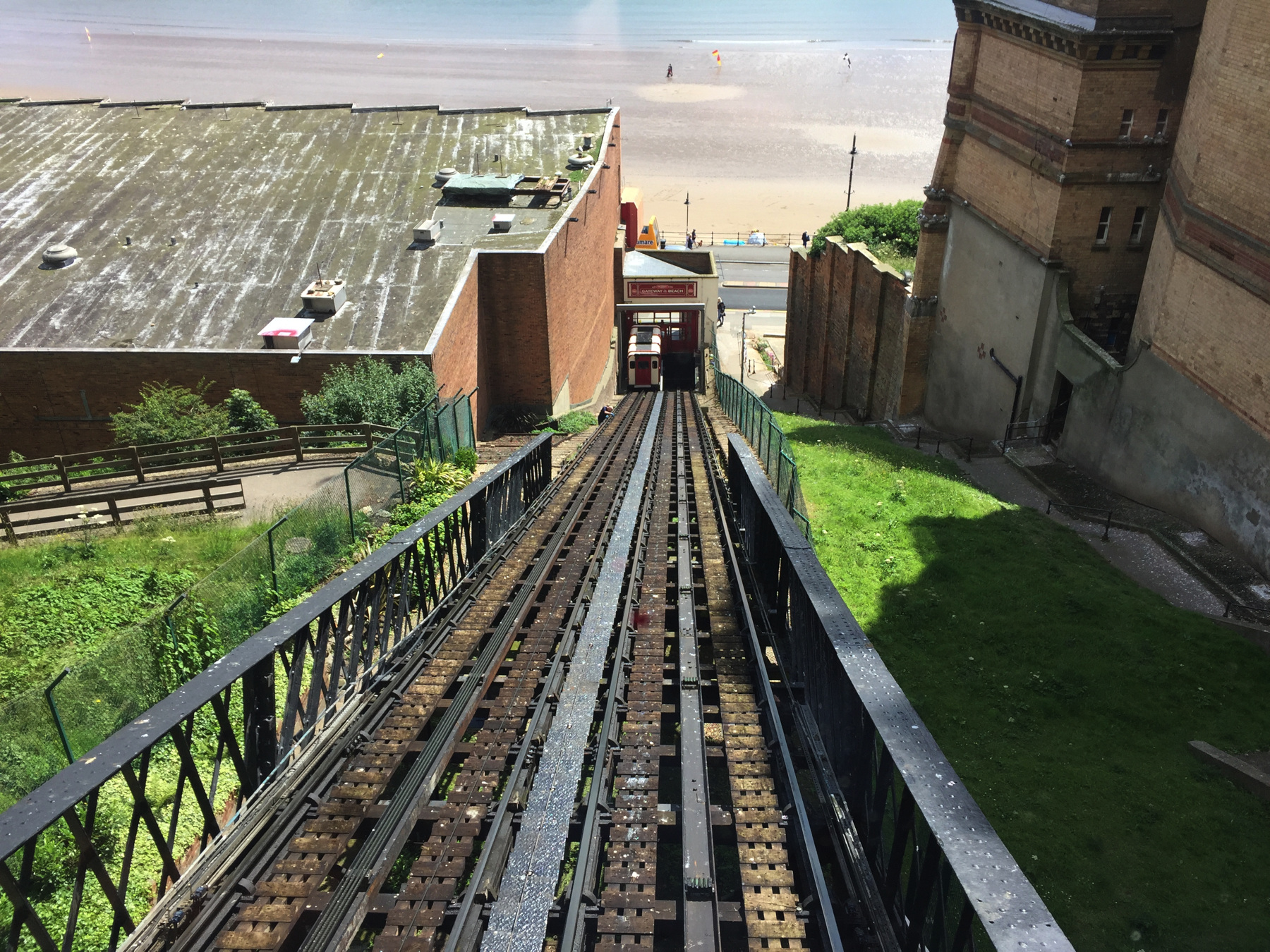
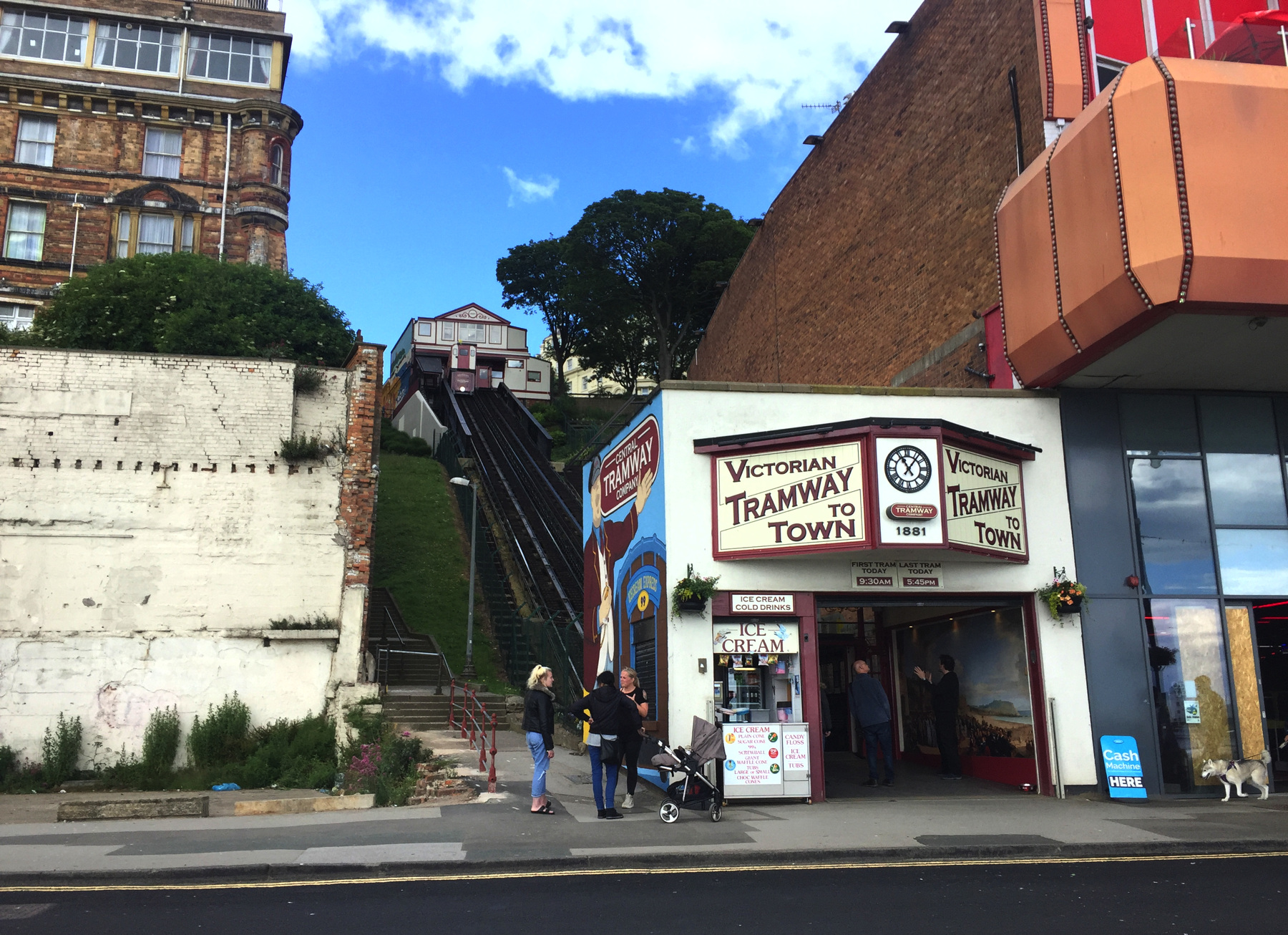
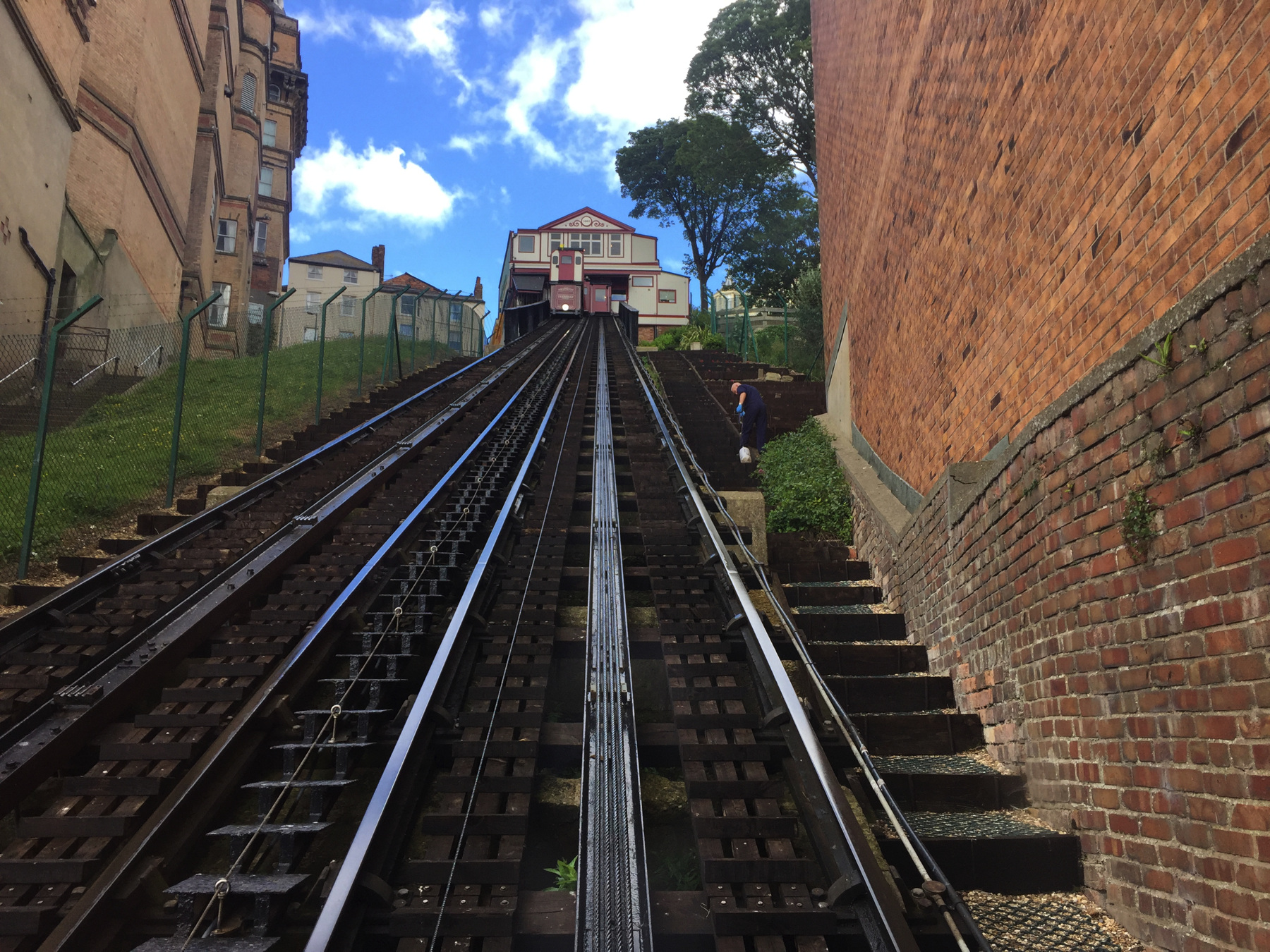
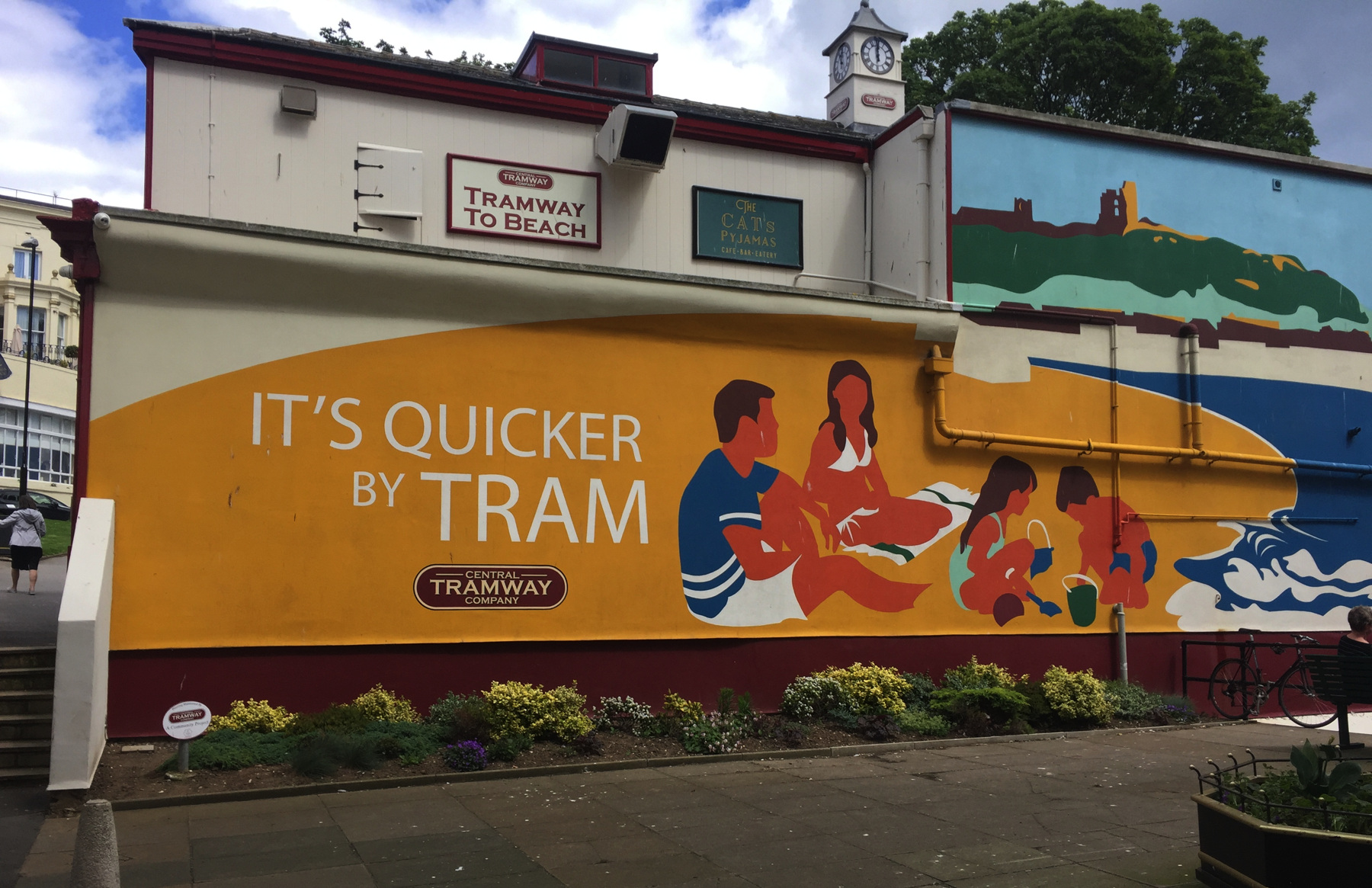
Saint Nicholas Cliff Railway
The Saint Nicholas Cliff Railway was right on the other side of the Grand Hotel from the Central Tramway, and its purpose was to supplement the Central in handling crowds. When it needed safety upgrades in 2007 it was closed since the Central Tramway can handle today's traffic. However just in case, not much of it has been removed. The track is still in, and both stations have not been removed but have been converted to commercial use. What looks almost like two cars together (which would never happen!) is a structure added over the tracks behind the upper station to provide good views from the cafe.
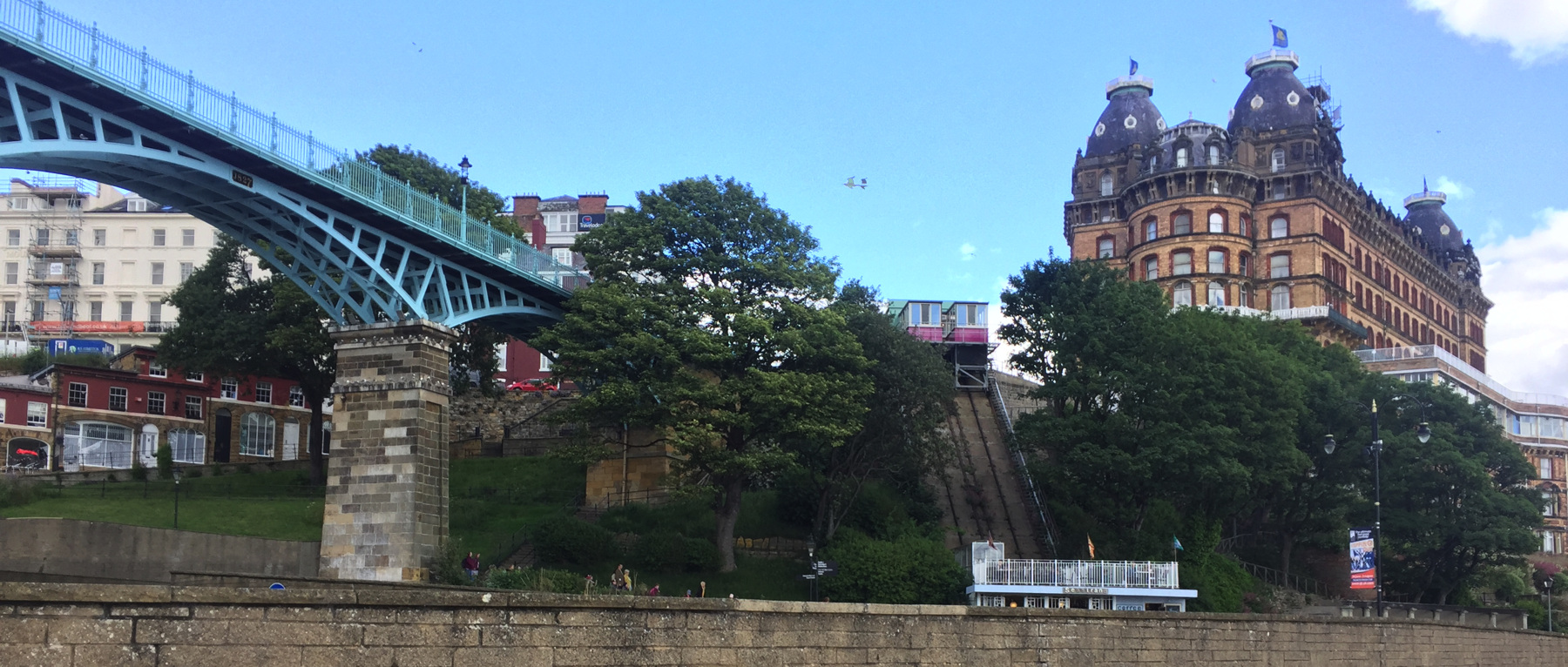
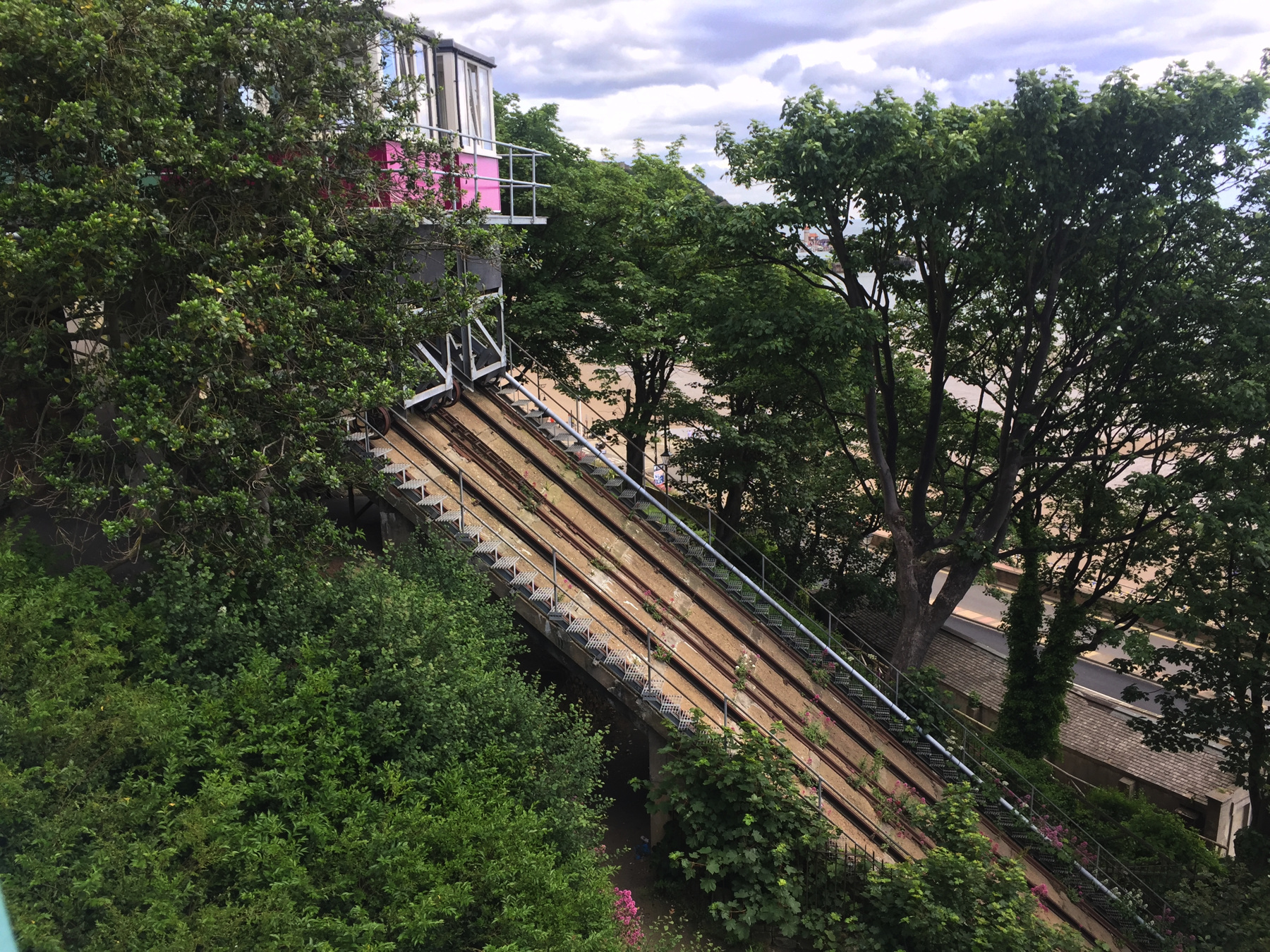
At this point I took a lunch break. On my way I had spotted a roomy railway-themed pub called the Scarborough Flyer near the Central Tramway upper station, so of course I went there. I found its interior decorated with photographs of the one-time train by that name from London, old timetables and notices, and other historic images of Scarborough. And a good piece of advice:
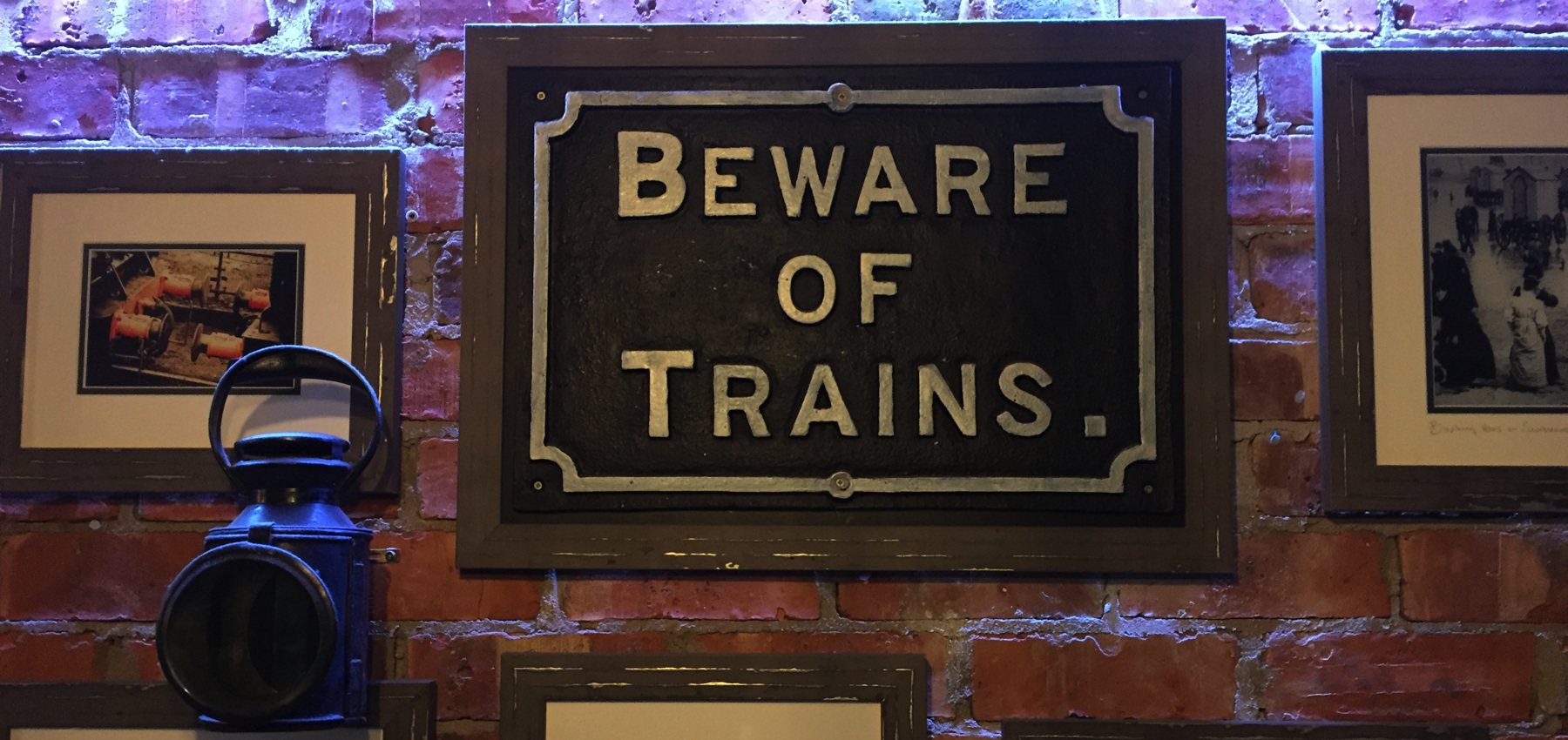
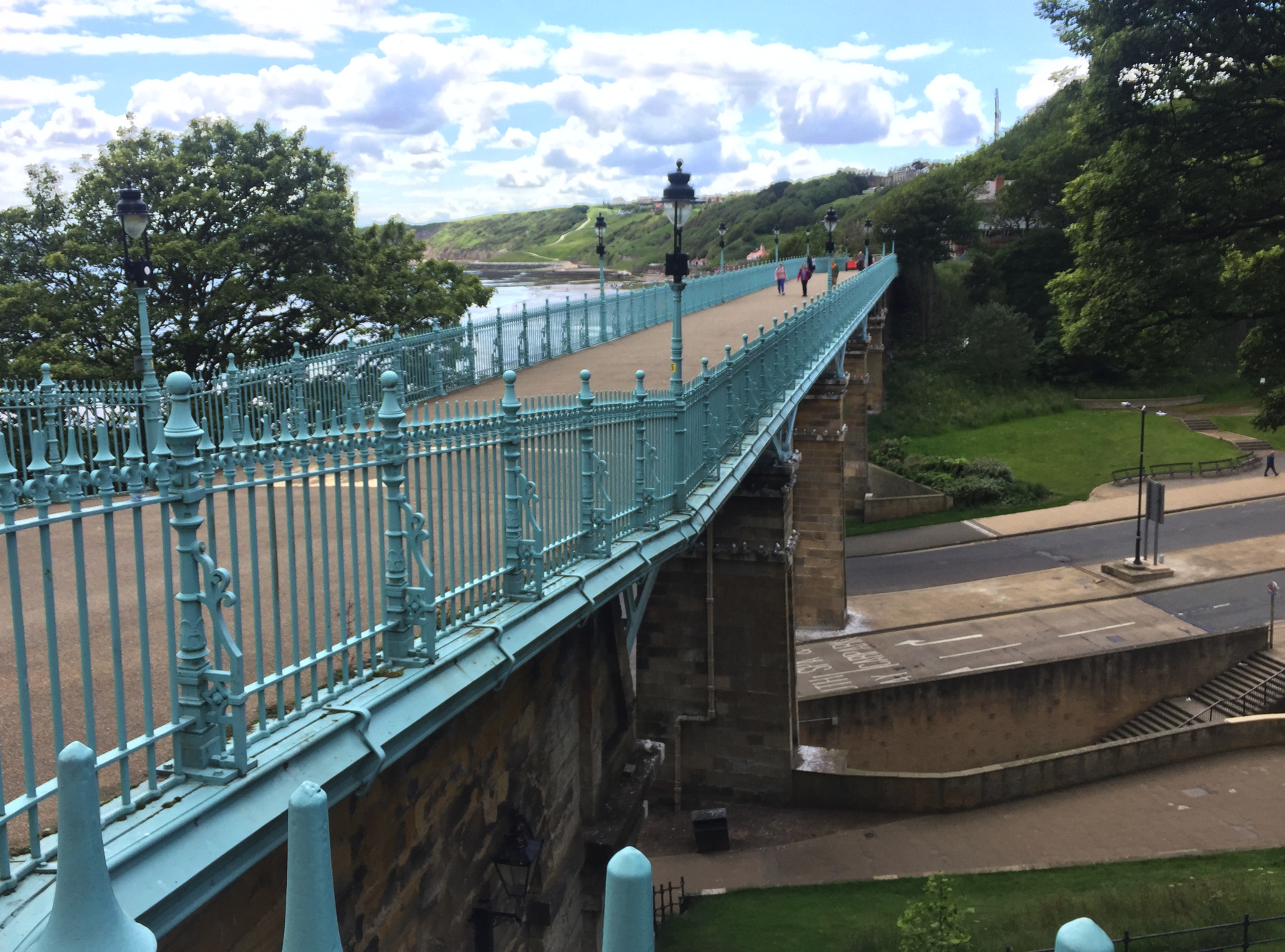
Near the former St Nicholas funicular is the Spa Bridge, the route to the Spa funicular some distance off. But before you go, find on the right the Rotunda Museum. The entrance is down in the valley. The museum was opened in 1829 to show the collections of its designer, William "Strata" Smith. By chance I had read not long before the book The Map That Changed the World, about Smith's work, without any thought that I would ever see his museum.
Smith was a surveyor hired by a canal company in the 1790s. To determine the kind of rock below the surface in the vicinity, he visited mine shafts. Not an upper class man, he spoke freely with the miners, and as they descended the shafts they pointed out to him all the layers of rock, for which they had names, and from experience they told him that all the mines had the same layers in the same order. Later, as the canal work progressed, cutting through hills, he saw once again the same strata. Smith was inspired. The rocks told a story. This would be news to the scientific establishment. By 1815 Smith had used up most of his modest income travelling all over England, and that year he published the first geological map of the country. He also published a book pointing out that fossil shells could be used to match strata of the same age. Not until 1831 was the common man Smith recognized by the Geological Society of London, and ultimately he was called the Father of English Geology.
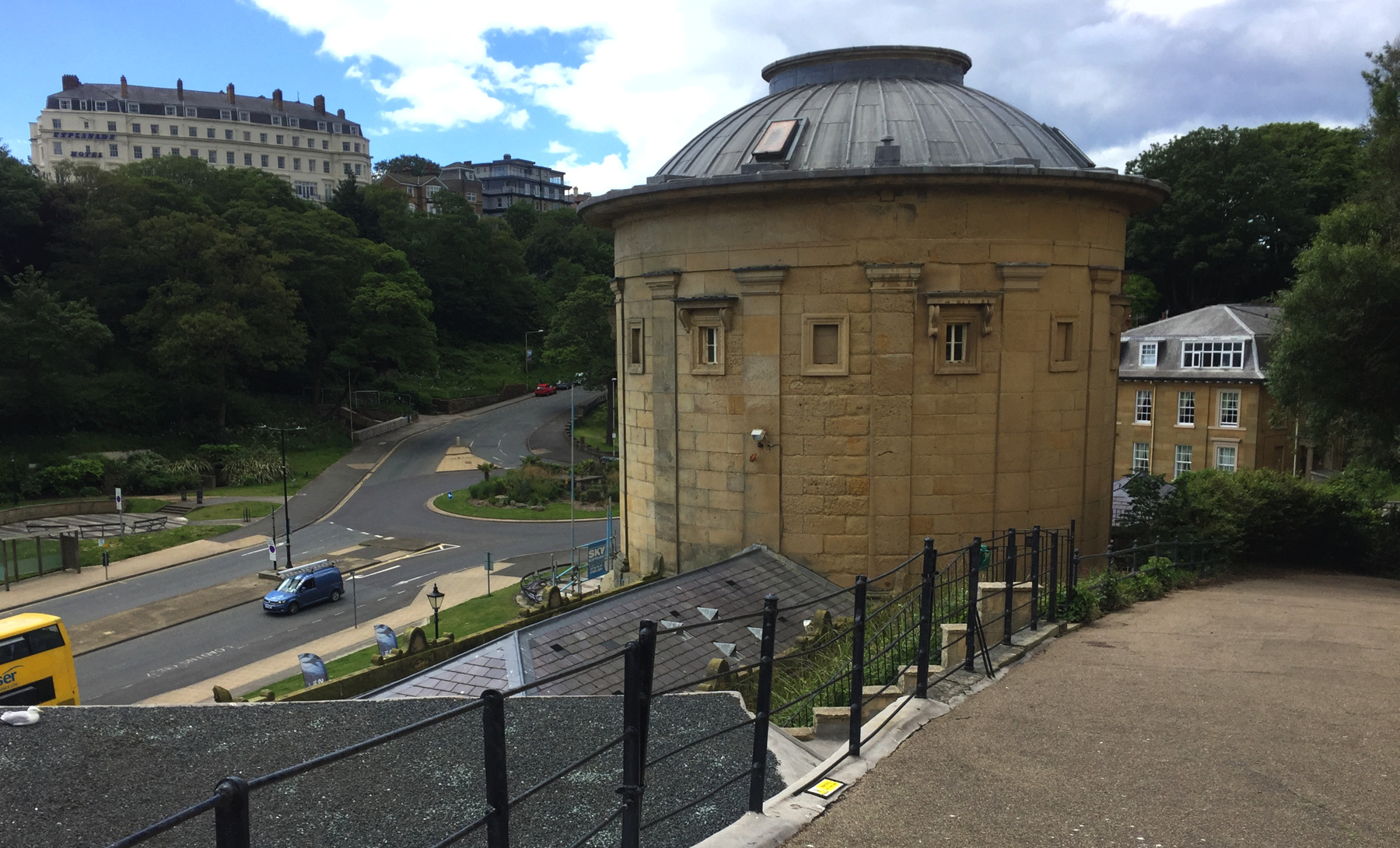
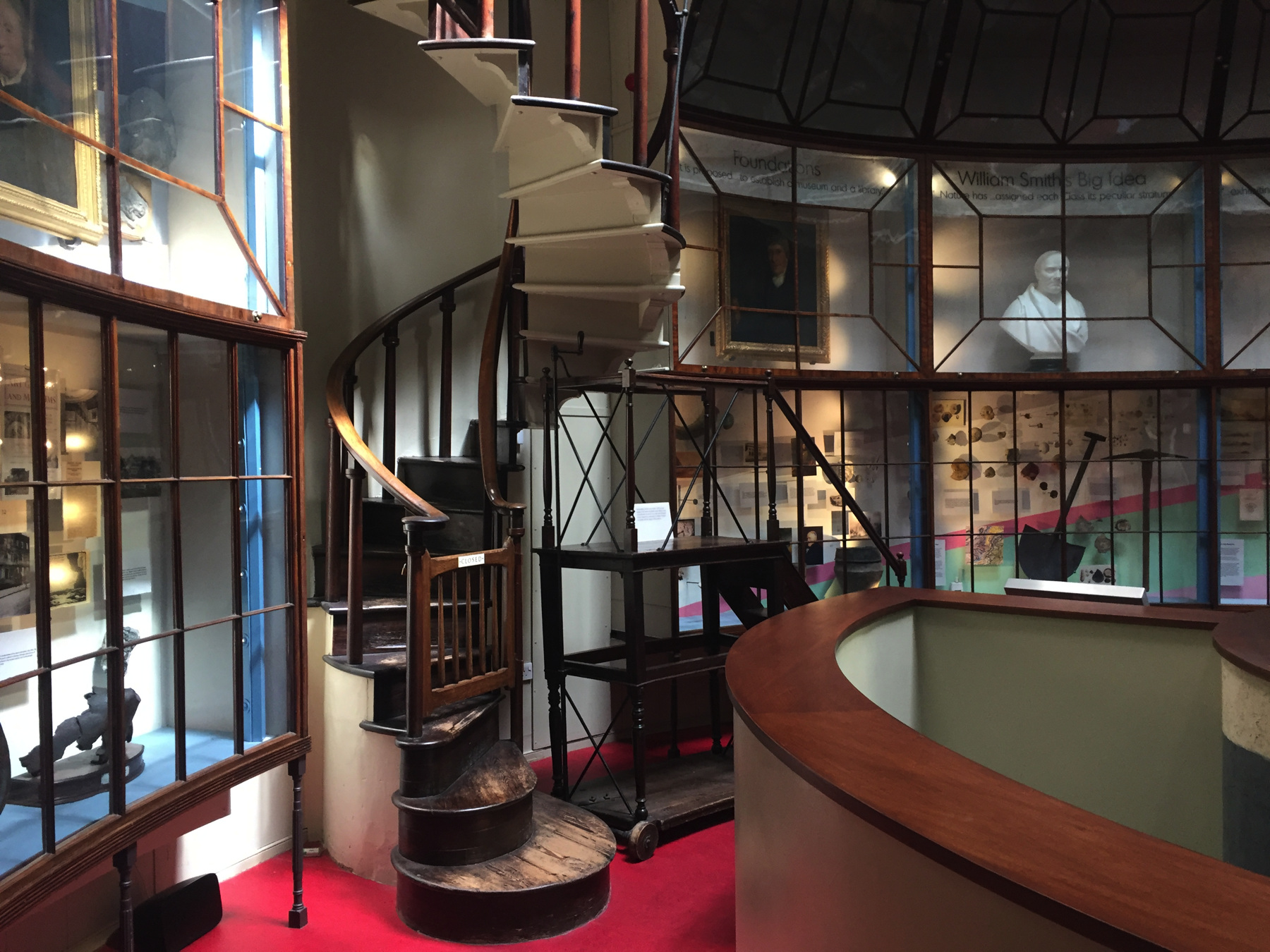
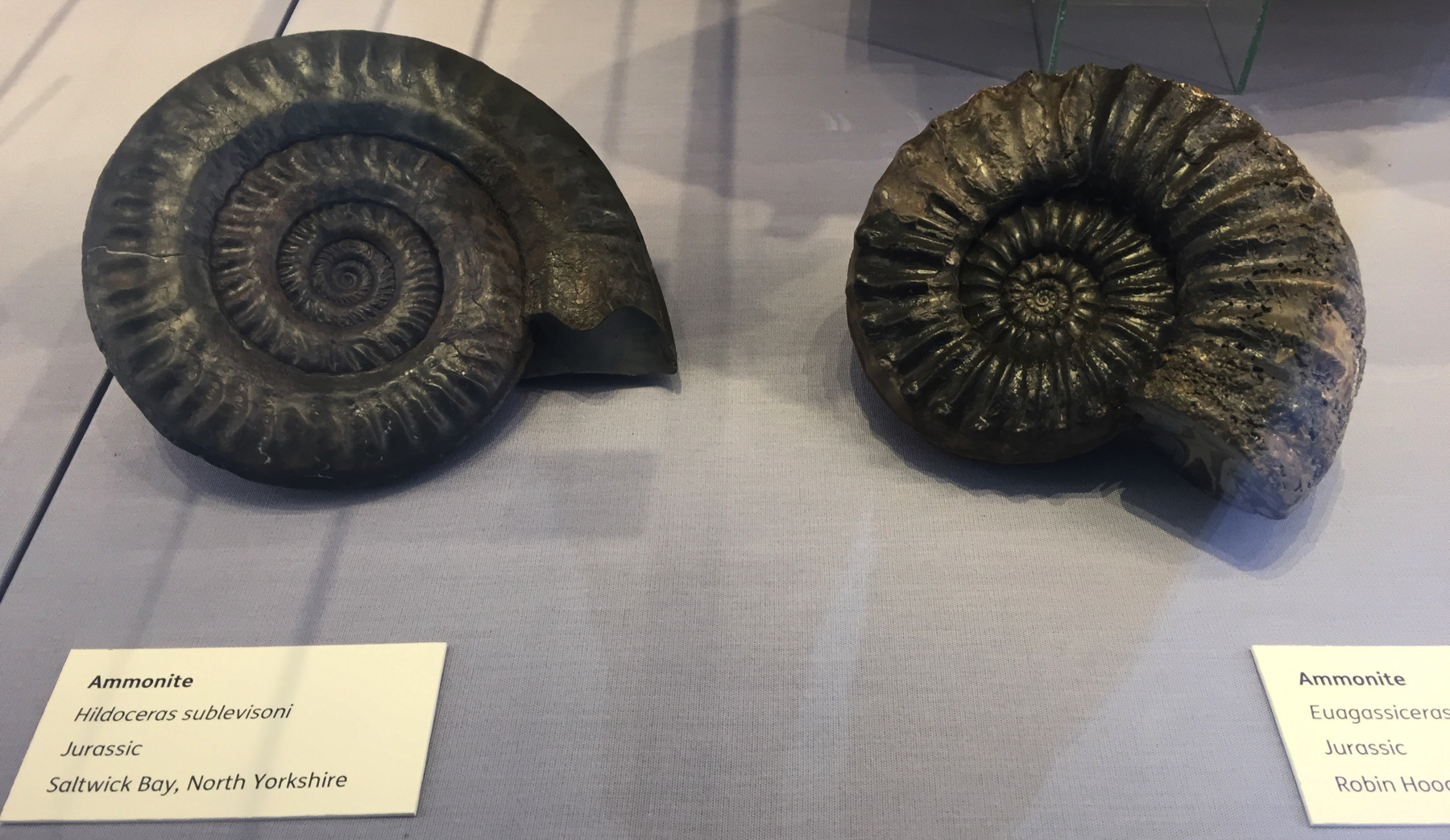
Scarborough Spa Cliff Lift
Now, on to the Spa. The first view below looks back north from the Spa Bridge. The former lower station of the St Nicholas funicular is at the extreme left, and that of the Central Tramway is just barely visible as the light blue paint this side of the orange rectangle. The remains of Scarborough Castle stretch across the top of the peninsula.
The second view, from a point south of the bridge, looks towards the Spa, the grand 1880 structure along the coast. The roundabout in the road is where I would catch a bus—but I am getting ahead of the story.
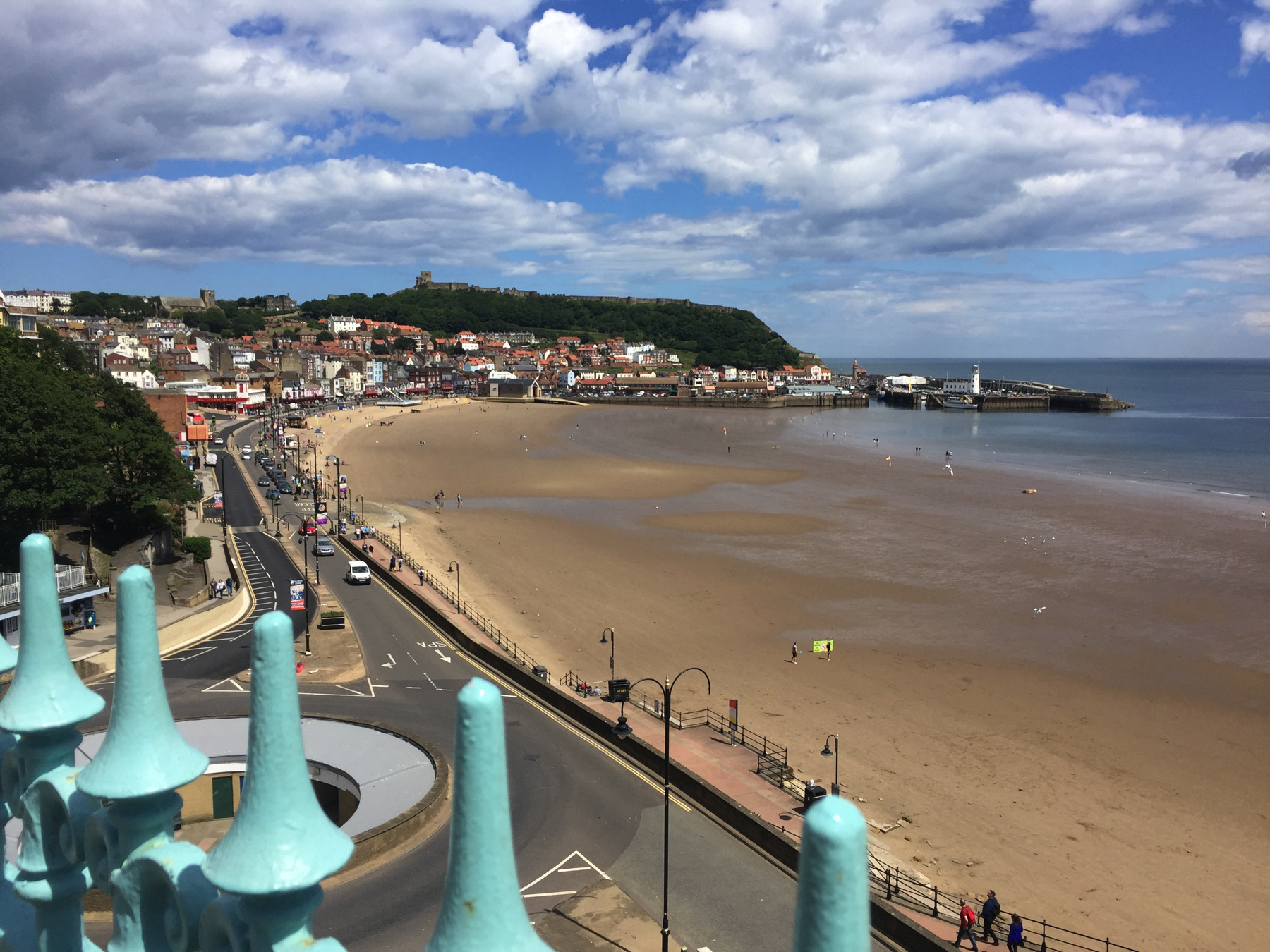
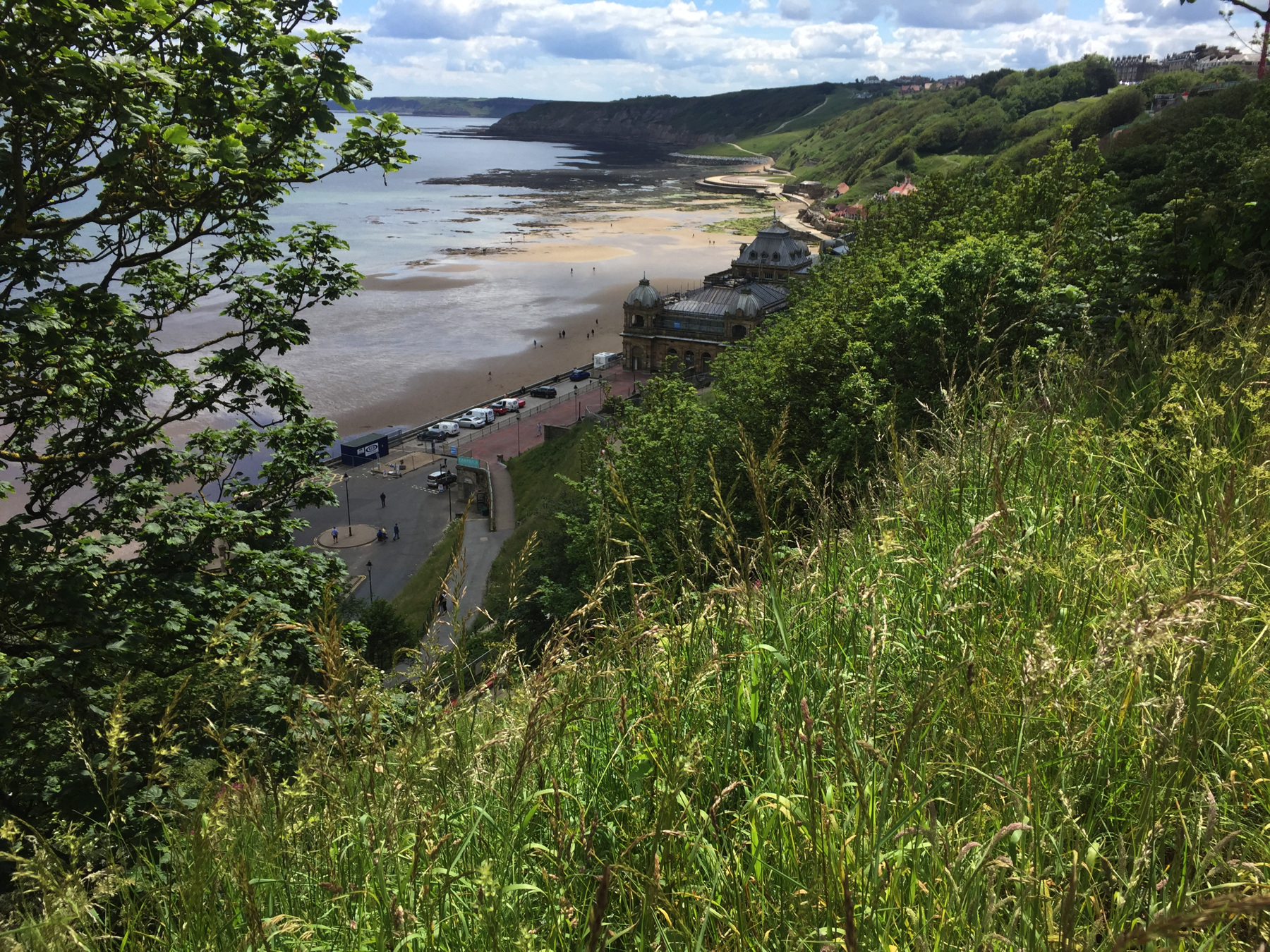
The Spa Cliff Lift is the poor relation of the Central Tramway. Signs don't even promote its name. Yes, Farrer's business at the Spa goes way back, and the regulars in town know the name, but could the upper station be any smaller? And does the cliff lift have a name at all? Here it just says cliff lift.
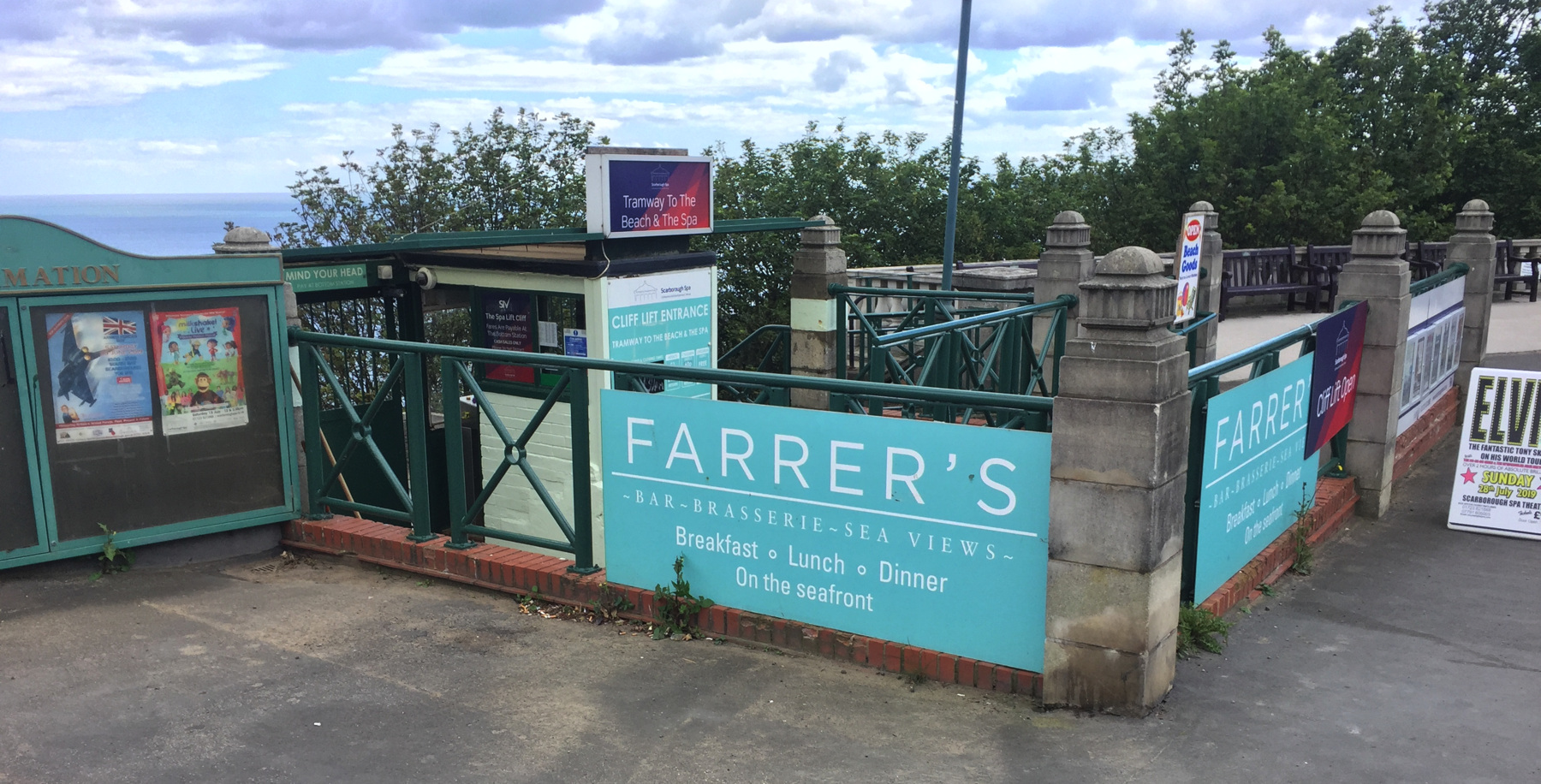
Let's ride down. The cliff was being landscaped in this whole area when I was there, but do notice especially where it comes right next to the tramway. There is a disused foot tunnel under it that is to be reopened as part of the work.
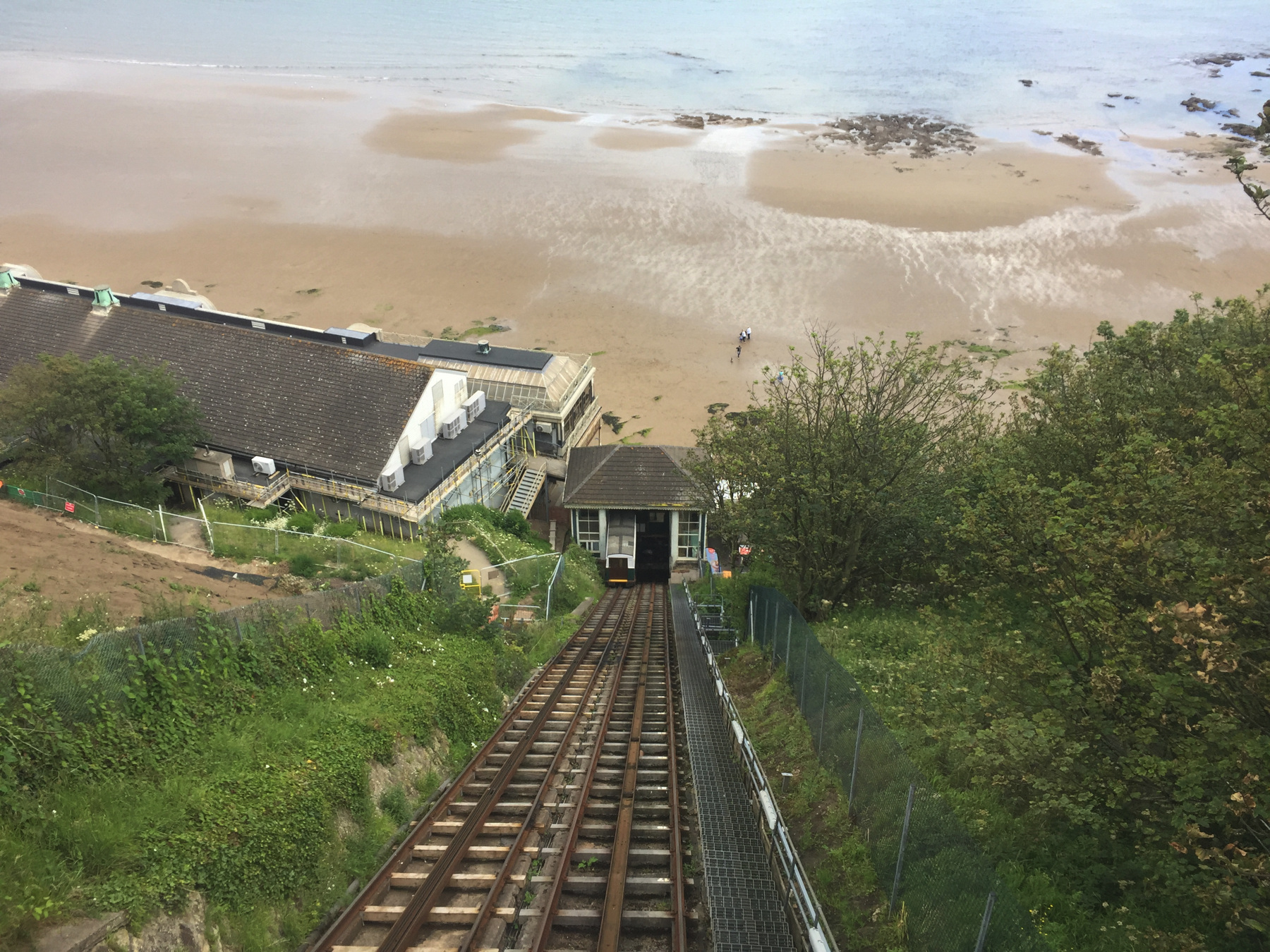
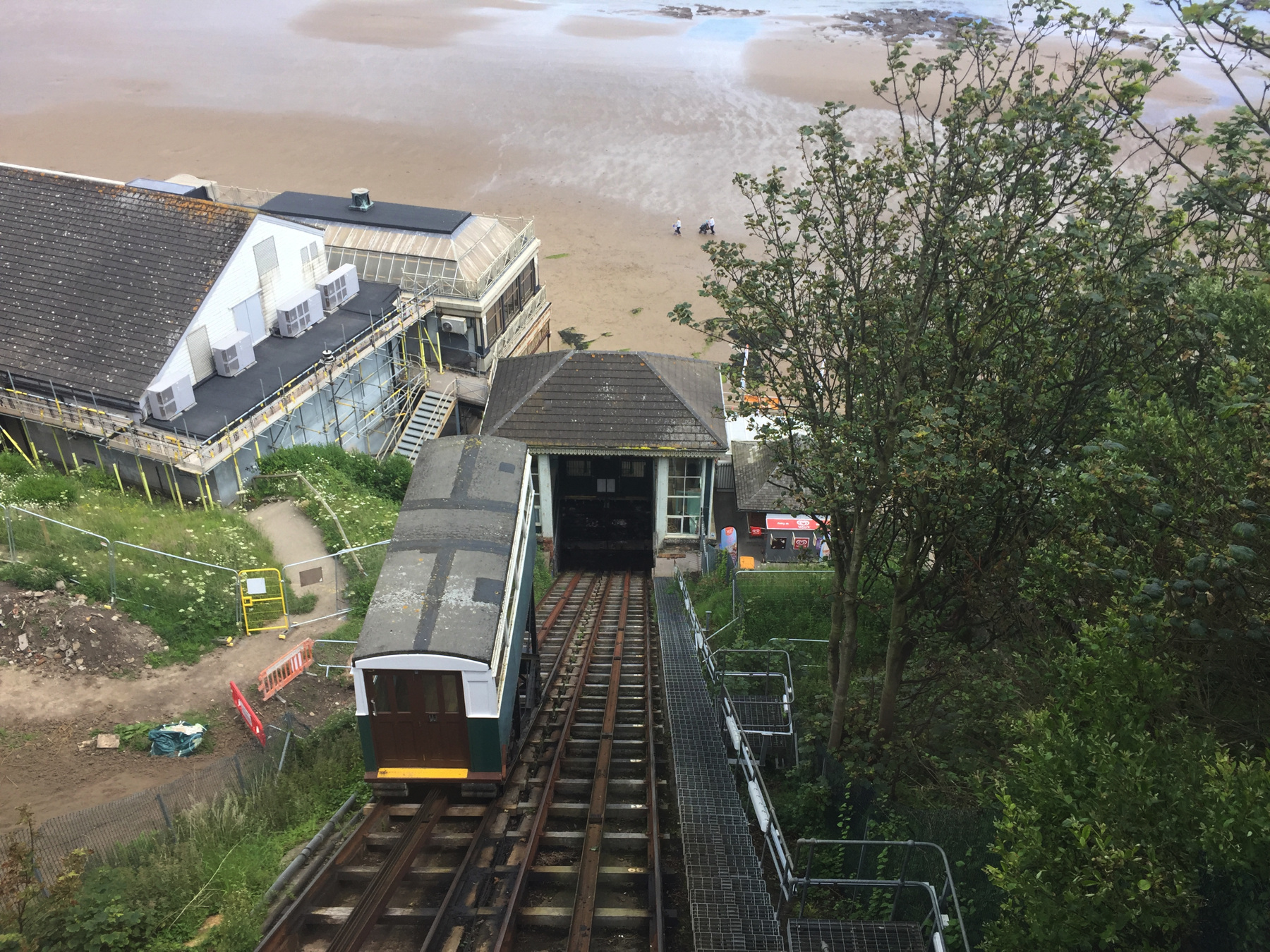
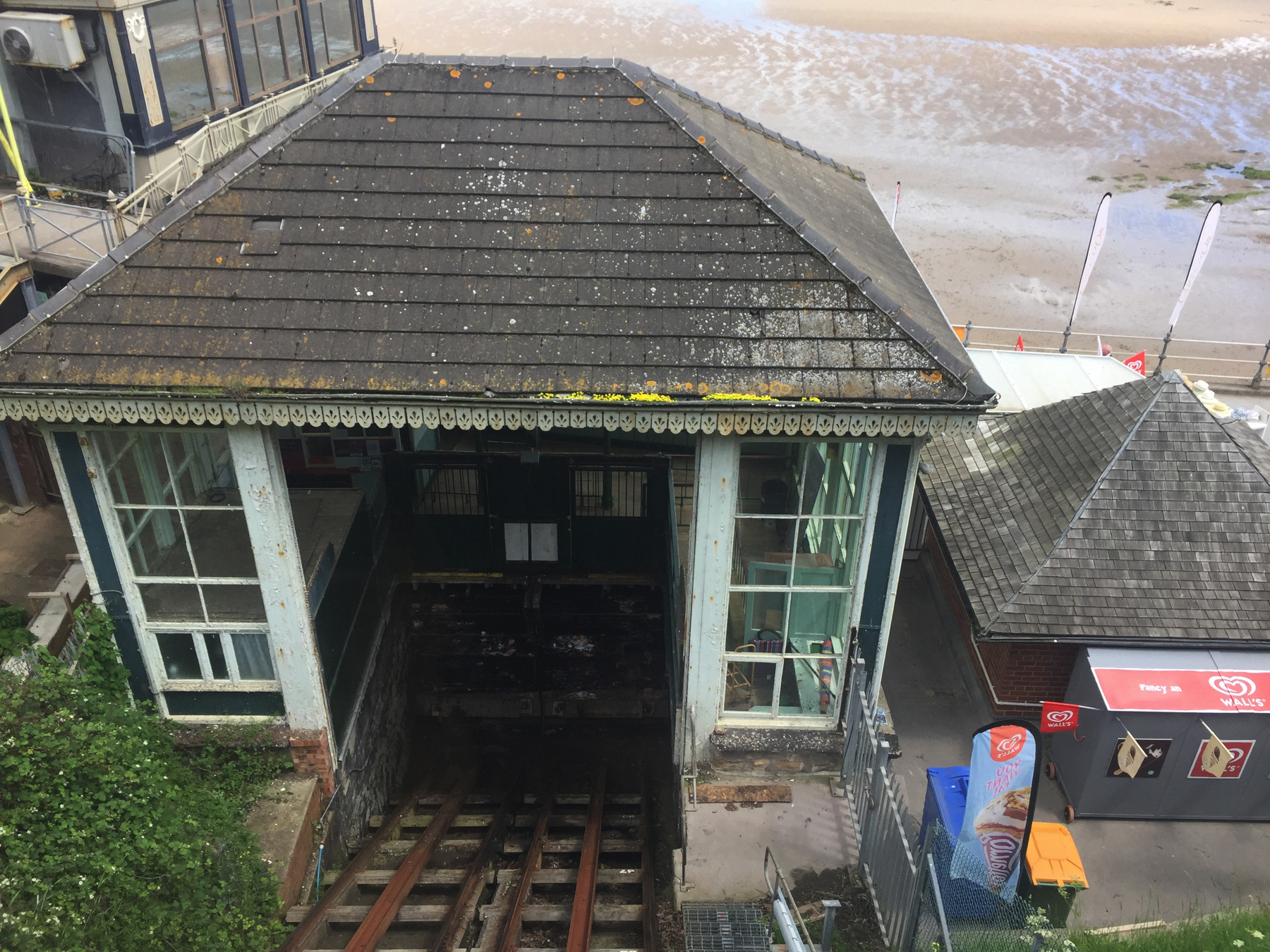
Look at the lower station house! It needs a little love, but it may be the original, which would make it a landmark in inclined railway history. This was the first funicular railway in Britain, opened in 1875, about ten years after the first ones on the Continent. The plaque gives the name as Scarborough Spa Cliff Lift, so I am going with that.
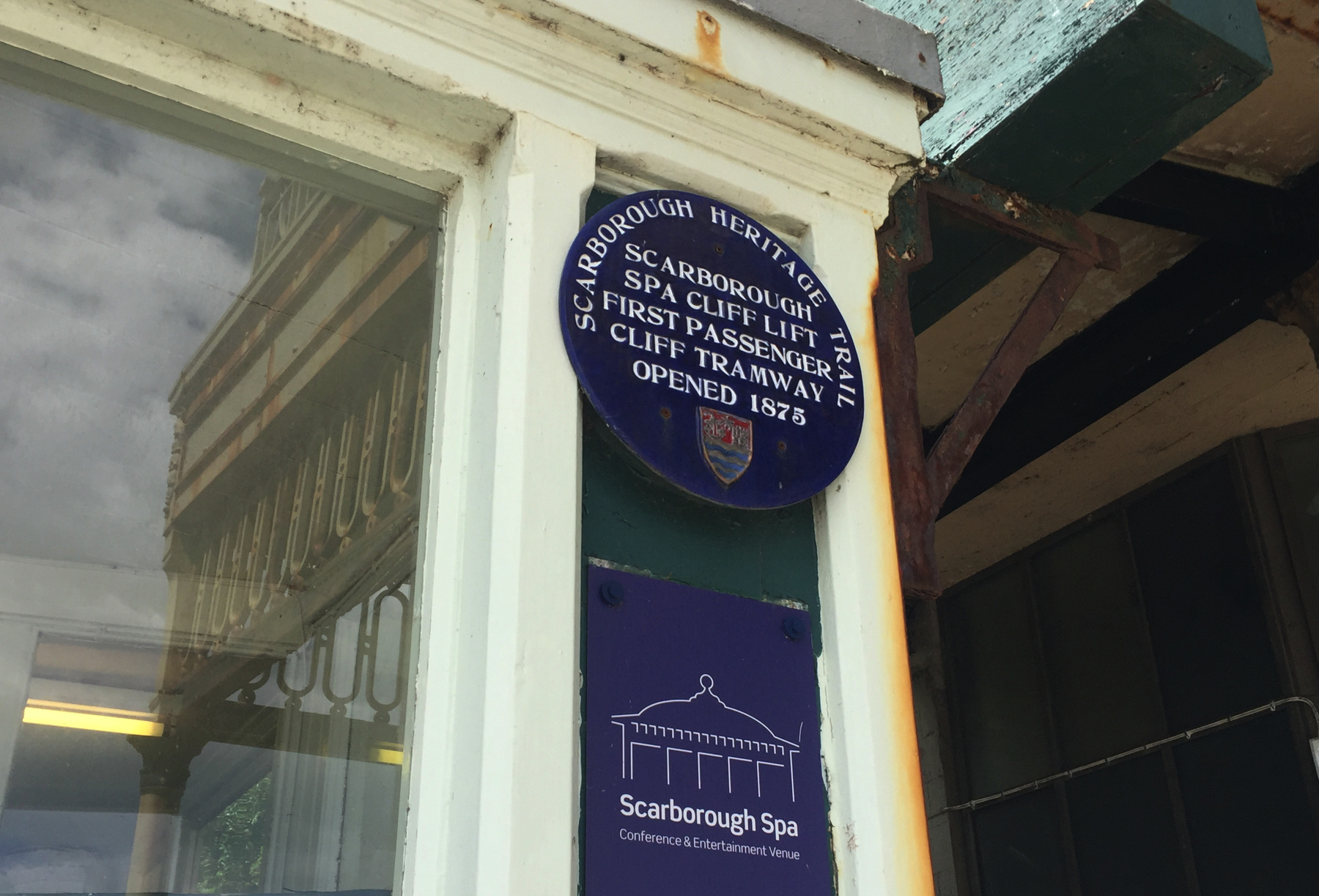
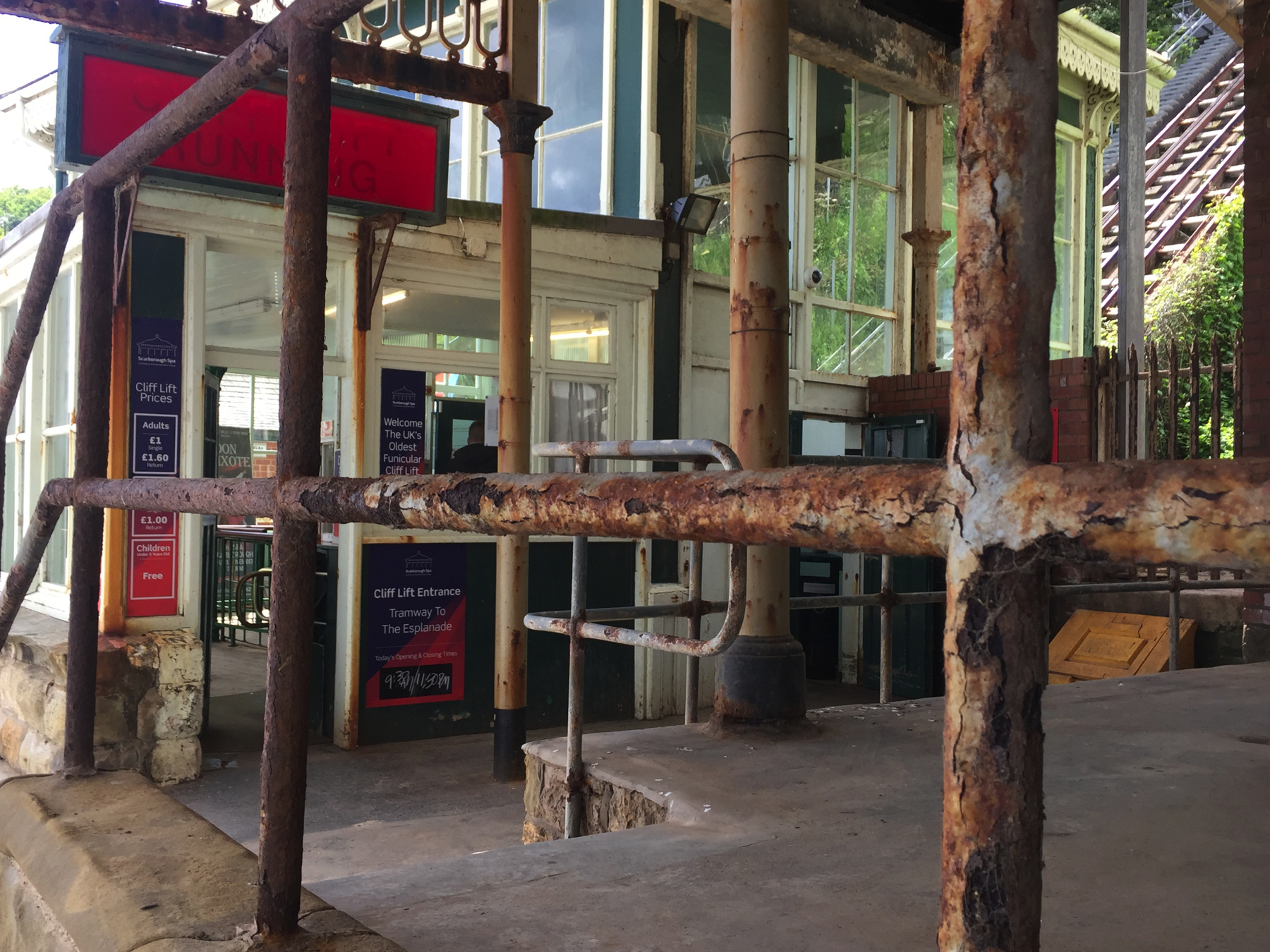
Has this part of the Spa been painted in this century? This area was the Café and Ballroom on old maps. The more northern part, the Grand Hall, Theatre, and Refreshment Rooms, is well kept todayand is full of people. There is a spacious restaurant and as you may have noticed at the top Elvis is scheduled to appear.
It was at this point that I decided that it was not necessary for me to ride both ways on a funicular for it to count. One way is enough. There was another place I wanted to go, and it departed from the road near the beach. Below, the view north from the Spa. The Grand Hotel always stands out, and the St Nicholas lift is well visible, and again the light blue next to the orange wall is the bottom of the Central Tramway.
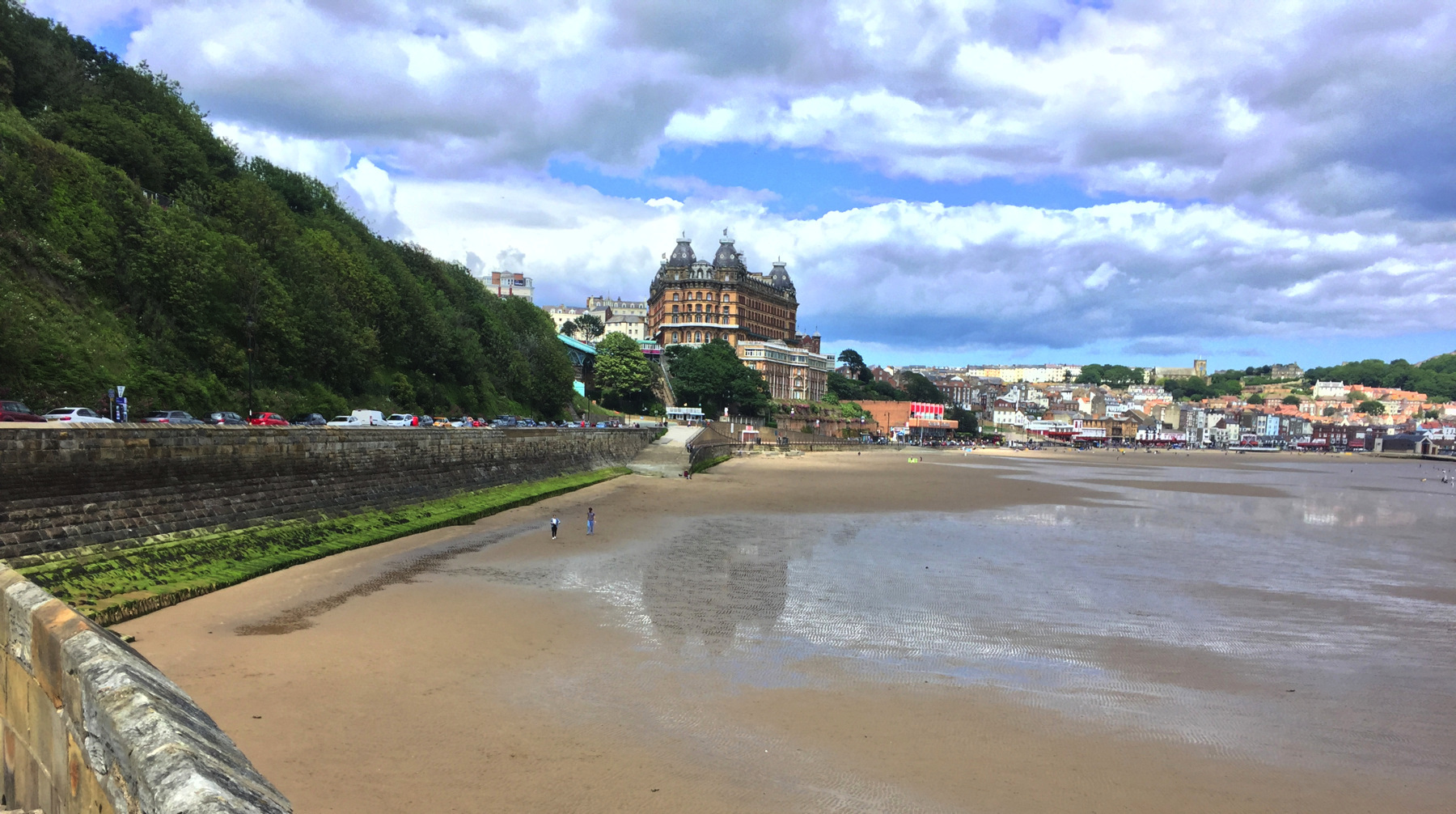
In summer there is an open top double deck bus that runs from the Spa along the coastal road to a place called Sands on the North Bay, meaning the coast north of the castle peninsula. From there if you walk up a street called Peasholm Gap you will find the North Bay Railway. It's just for fun. Built in 1931, it is a 20-inch gauge railway that runs almost a mile from Peasholm to Scalby Mills. The four original locomotives built from 1931 to 1933 look like steam but are diesel hydraulic, but Georgina, built in 2016, really is a steam locomotive.
In these pictures I think the stub switches (points) are of interest, being an early type on railways that is practically never seen today. Then there is the fake steam locomotive Scarborough Flier [sic] that pulled us north, and the real steam locomotive Georgina, on the turntable, that took us back. It's a good ride. There's even a little tunnel.
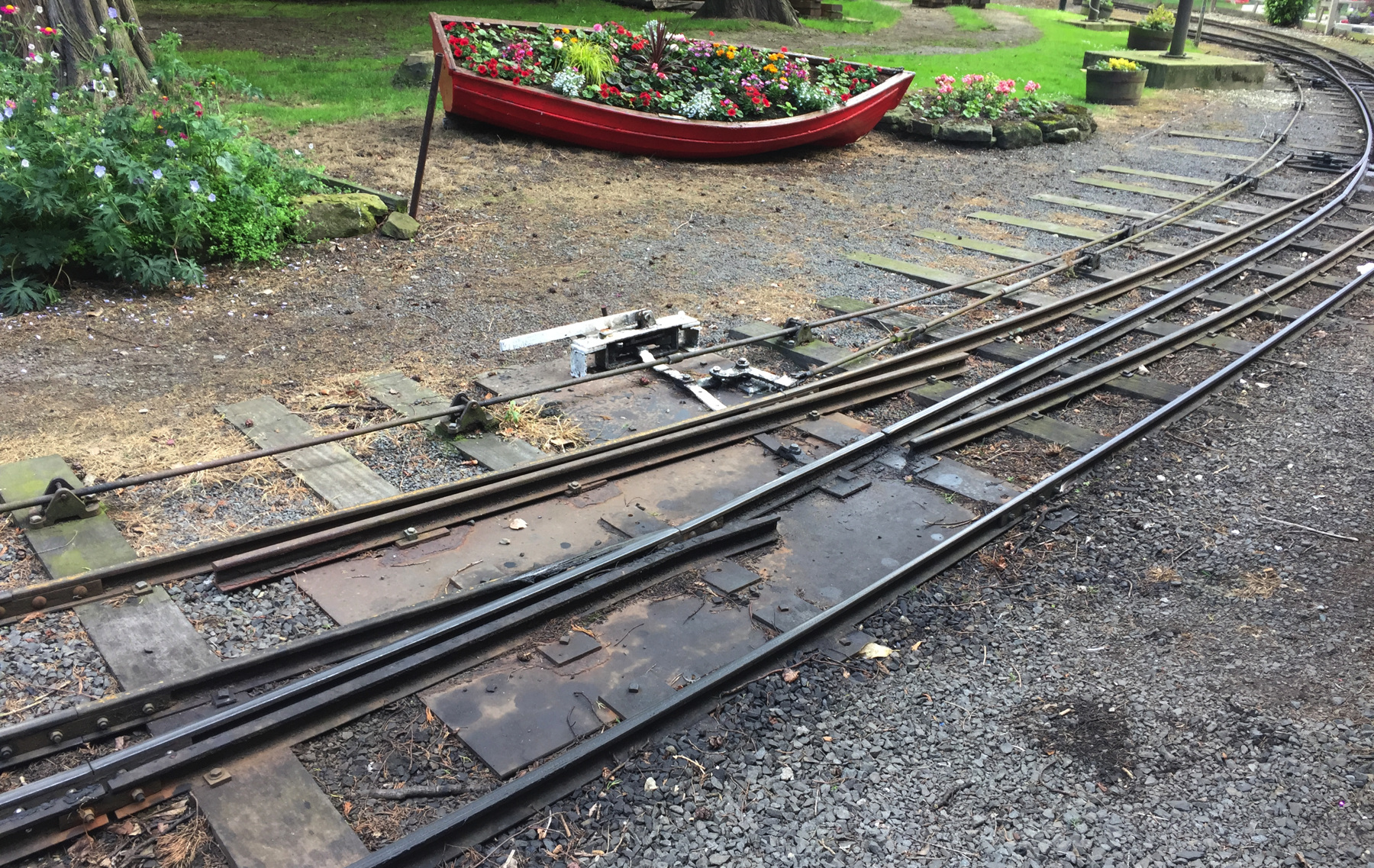
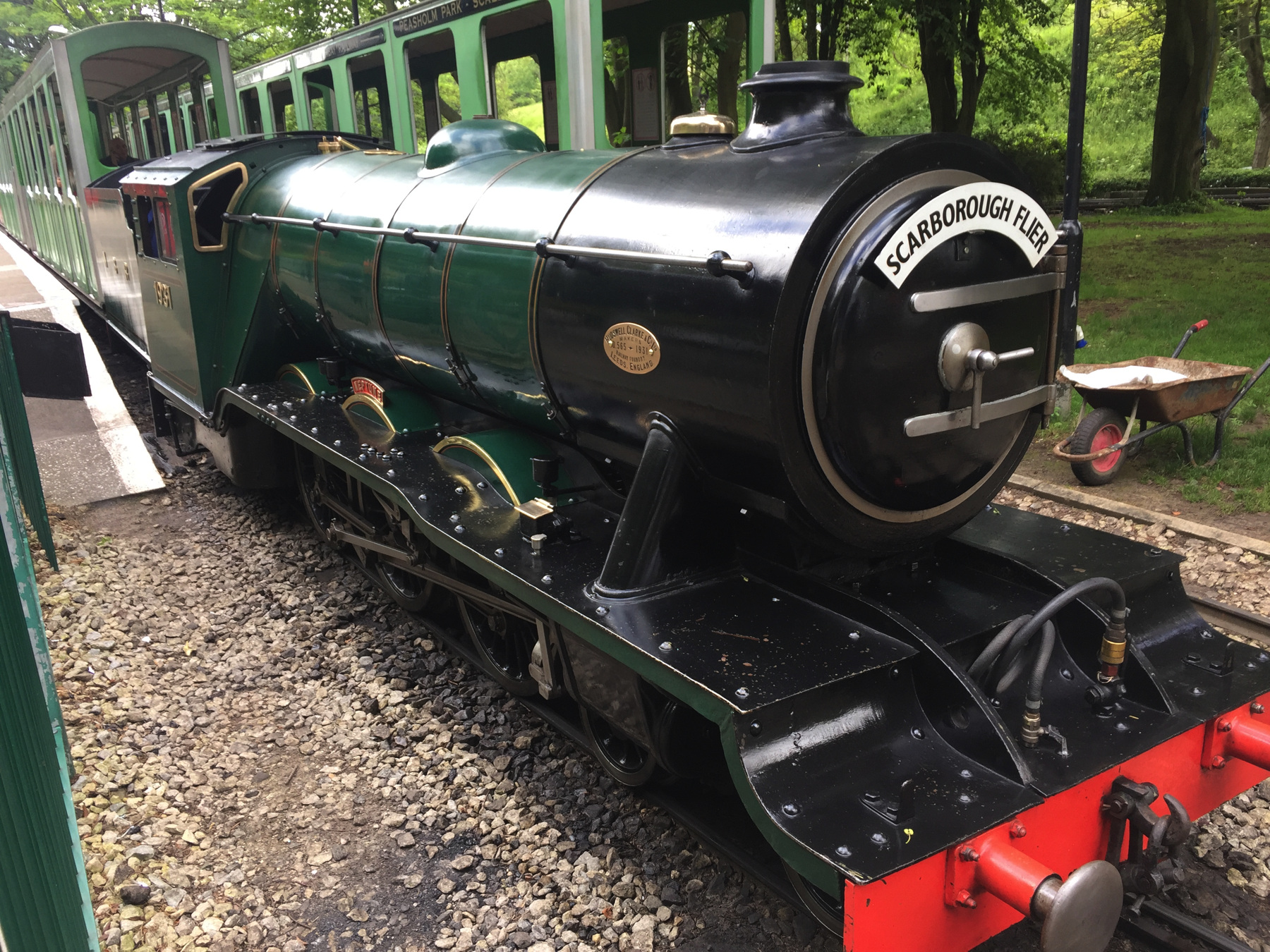
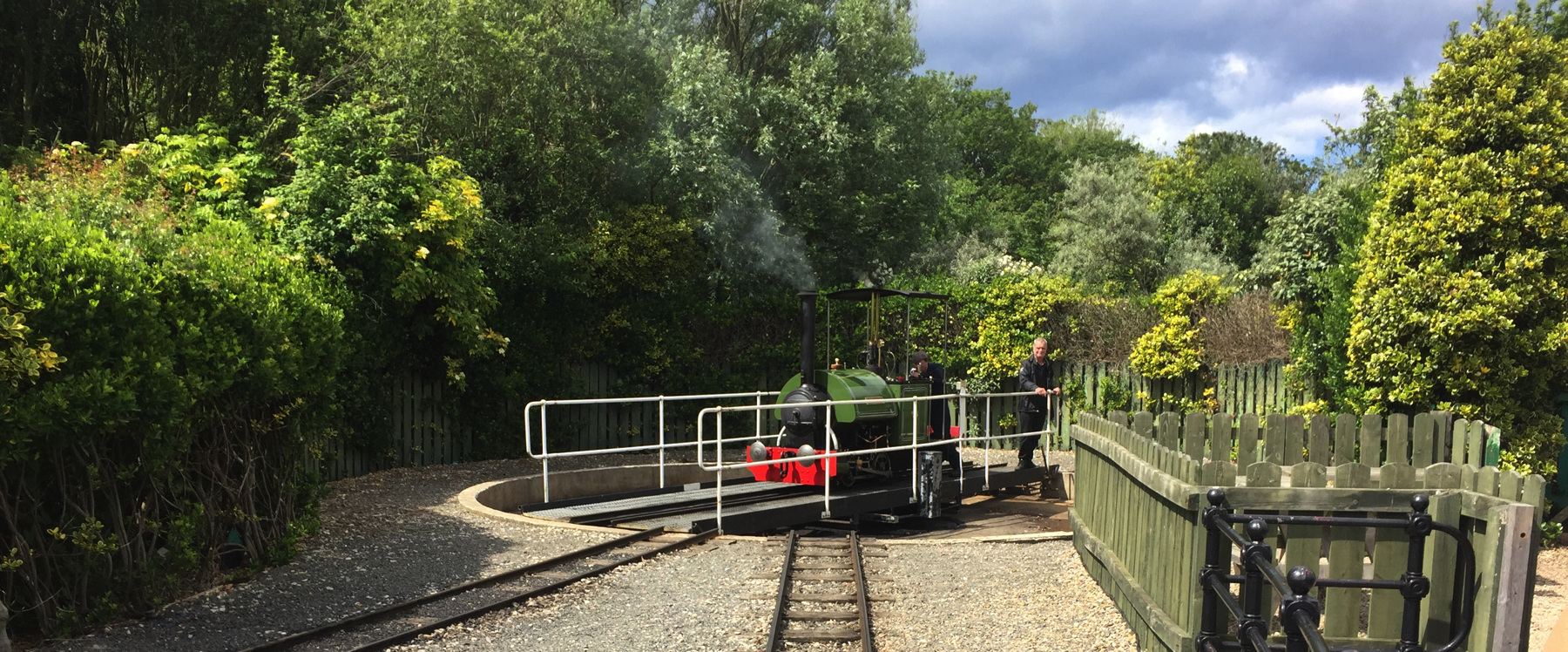
The interesting part of these journeys so often ends at the farthest point. Waiting for the bus at North Bay, I doubted that I could reach the lower station of the Central Tramway, ride up, and walk to the railway station in time for the next train—but why not try? The Central became the only funicular I rode three times, and I did make it to the train, less than ten minutes before departure.
For the first time in three days I was back in London at a reasonable hour. I took a second pub meal and went off to bed in the hotel.
[note 1] My friend Clive informed me that the main reason for not renumbering all the tracks is not customer relations but something behind the scenes. It would require changing all the signalling; there are 12 signals that display platform numbers, with some horribly large number (56, I think) of routes that would require rewiring in the interlocking and testing. As an IT professional myself I can appreciate the difficulty of getting so many changes exactly right, and the consequences of error ranging all the way to fatal could be far worse than anything I have had to worry about. He went on to add that in addition there would be the cost of re-training every one of the large number of drivers who brings a train into Kings Cross. Google Satellite imagery shows the track from 0 joining a track from 1 not far outside the train shed—that's all it is.
TODAY'S FUNICULAR : 1
Central Tramway, Scarborough
Date: since 1881
Power: Electric motor
Rise: 81 feet
Run: [about 220 feet]
Length: 234 feet
Slope: 36%
Gauge: 4 feet 8½ inches
Track: 2 tracks, straight
Car: level floor, doors at ends
The engine house used a stationary steam engine until 1910.
CLAIMS: The oldest cliff lift company still operating. True. It is also the second-oldest funicular in Britain.
HEIGHT: The height of 81 feet and track of 234 feet are consistent with the run of about 220 feet. Ordnance Survey maps give spot elevations of 33 for the Foreshore Road at the bottom and 112 near the upper station, and that matches closely to the 81 feet.
TODAY'S FUNICULAR : 2
St Nicholas Cliff Lift, Scarborough
Date: from 1929 to 2007
Power: none
Rise: [about 45 feet]
Run: [about 60 feet]
Length: 102 feet
Slope: 75%
Gauge: 7 feet 6 inches
Track: 2 tracks, straight
Car (no longer on site): level floor, doors at ends
HEIGHT: This one was very short and very steep. The track and slope are given in sources, and the run is measured on a map to about 60 feet. The calculated rise of 45 feet and the 33 feet elevation at the botom brings the top elevation to 78, which looks right since I saw that the road goes down hill from the 112 feet elevation near the Central Tramway, past the upper station of St Nicholas, and on to a spot elevation not far away of 72 feet on the Ordnance Survey map. I accept 75% as the steep slope (45 degrees is 100%).
TODAY'S FUNICULAR : 3
Scarborough Spa Cliff Lift, Scarborough
Date: since 1875
Power: Electric motor
Rise: [about 152 feet]
Run: [about 220 feet]
Length: [268 feet]
Slope: 69%
Gauge: 4 feet 8½ inches
Track: 2 tracks, straight
Car: level floor, doors at ends
The railway was water balanced until 1947.
CLAIMS: "The first passenger cliff tramway" is true, for the United Kingdom. The qualification "passenger" is there to exclude tramways carrying ore from mines. Some of those went down cliffs and were worked with chains or ropes. Some even used the weight of the loaded cars to pull up the empties, but I know of no case where the cars were in pairs permanently attached, so the tramways were not funiculars. I wonder if there ever was one.
HEIGHT: The measurements given in my sources do not compute: track 286 feet and rise of 84 feet. That would require a run of 273 feet, but measurements on a map show the run to be nearly identical to the Central Tramway, 220 feet. Taking another approach, Ordnance Survey maps suggest an elevation of about 176 feet near the upper station and 24 near the lower, a height of about 152 feet, not 84, and given the run of 220 feet, the track would be 267 feet. Although I tend to think the reported track length is the most accurate number, in this case I propose that a typo turned 268 into 286, and if so the rise and run shown above will be approximately right.
TODAY'S ALE
Scarborough Flyer, Scarborough: Sharp's Brewery, Doom Bar (cask ale)
Water Rats, London: Fuller's Brewery: London Pride (cask ale)